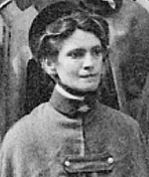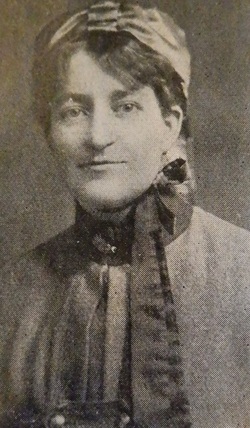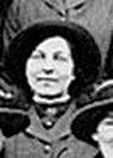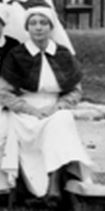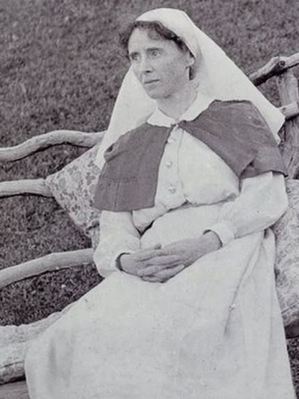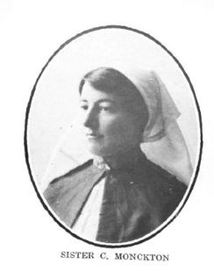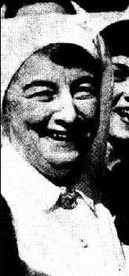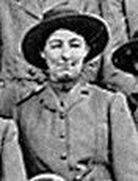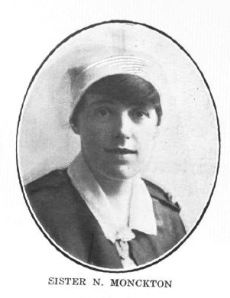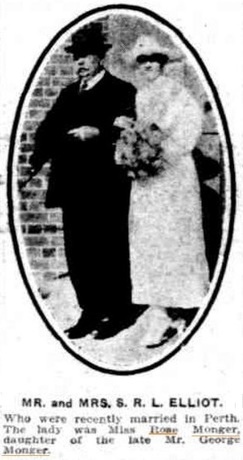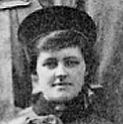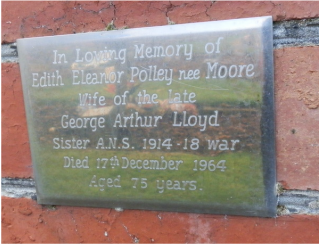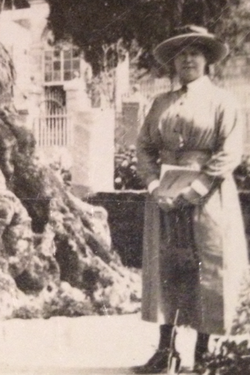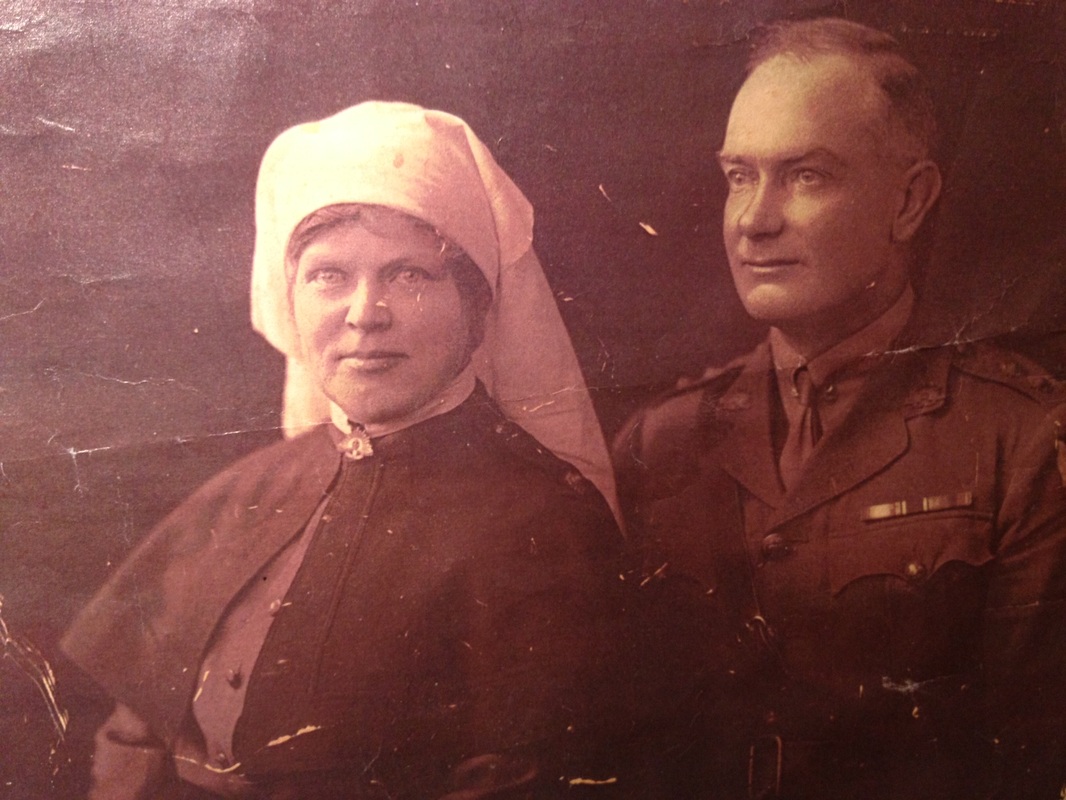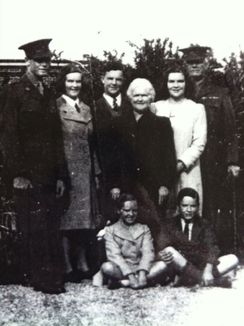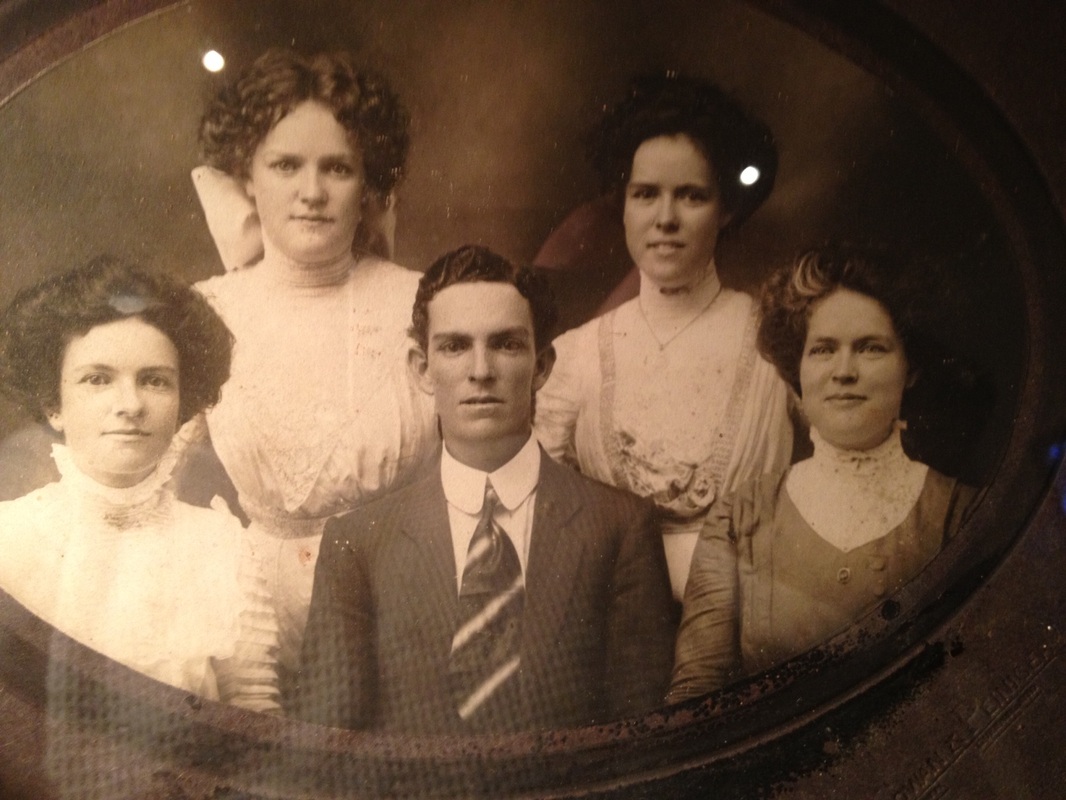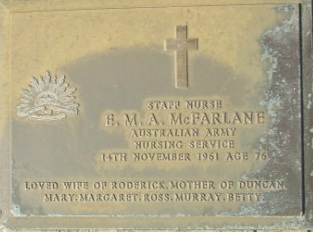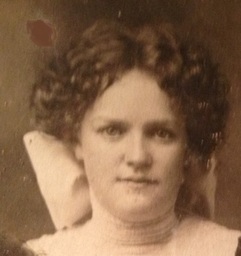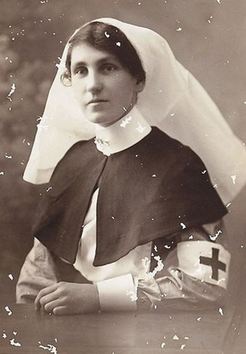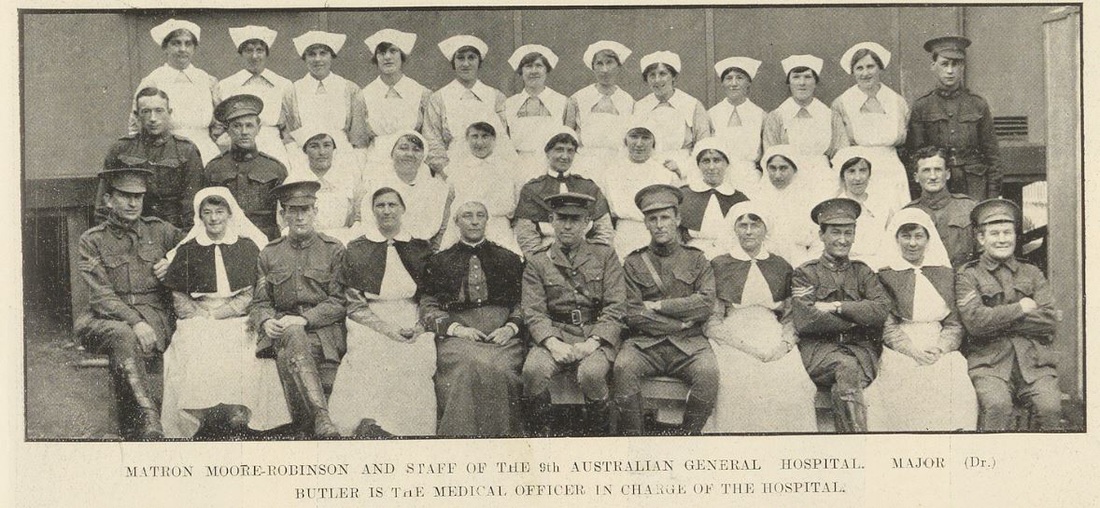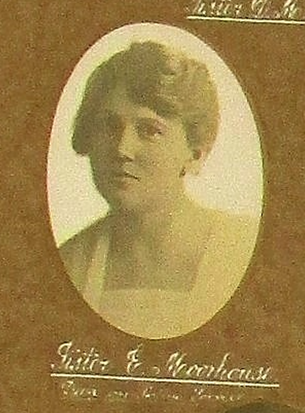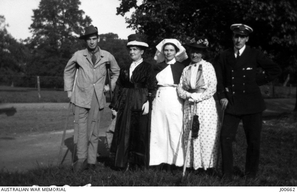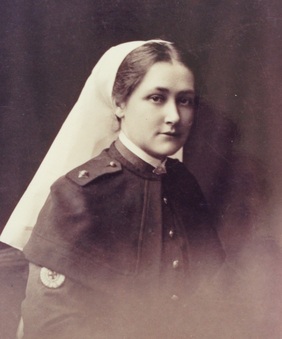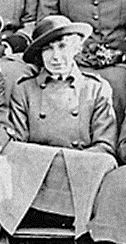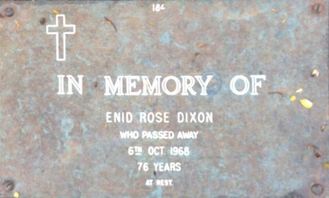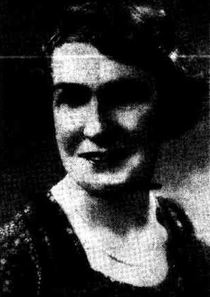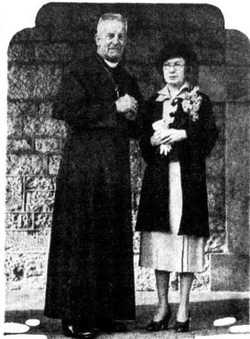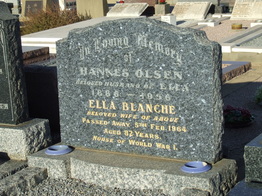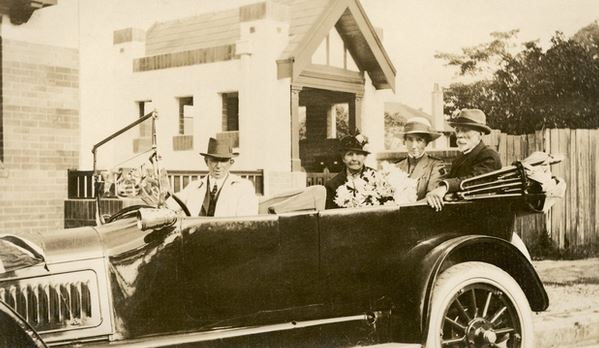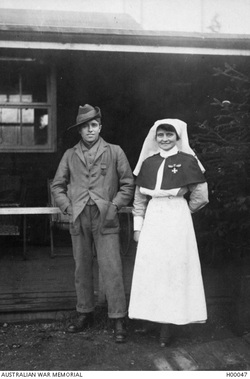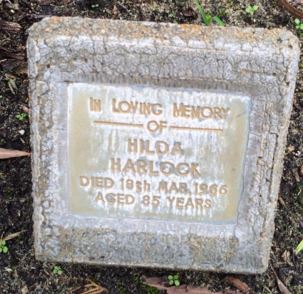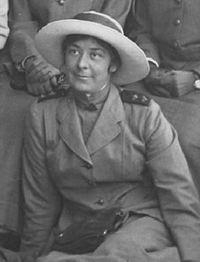MOBERLY, Gertrude Frances
|
Sister
AANS Born 1880 in Rockhampton, Queensland Daughter of Edmund G. MOBERLY Of Hardy St, Neutral Bay, Sydney, NSW Occupation prior to enlisting Nurse Enlisted 14 July 1915 Embarked: 12 August 1915 from Sydney per ‘Orsova’ Aged 35 years Served in No 6 Australian Army Hospital Suez 9/5/1916 No 6 Hospital closed. Duty in charge nursing staff on transport ship ‘Euripides’ to Australia Re-embarked 5 September 1916 per ‘Kashgar’ nursing staff for India Appointed Temporary Matron, reverts to sister Embarked for Australia 13 April 1919 per ‘Castalia’ in charge nursing staff Disembarks Sydney on 1 June 1919 Appointment Terminated 1 August 1919 Married James Thomas HOGAN Died 20 August 1962 in Balmain, NSW |

Awarded Royal Red Cross (1st Class)
Date of Commonwealth of Australia Gazette: 11 December 1919
Location in Commonwealth of Australia Gazette: Page 2379, position 11
Date of London Gazette: 12 September 1919
Location in London Gazette: Page 11463, position 1
Date of Commonwealth of Australia Gazette: 11 December 1919
Location in Commonwealth of Australia Gazette: Page 2379, position 11
Date of London Gazette: 12 September 1919
Location in London Gazette: Page 11463, position 1
Intimate Letters Of a War Nurse
GERTRUDE F. MOBERLY has given us her experiences of a "dinki di" R.R.C. nurse in the form of letters. These are written to one Peter, and cover the war period from July, 1915, to April, 1919. The first is sent from the troopship "Orsova," outward bound, and the last from the home-coming hospital ship, "Castalia."
Intimate pen pictures of notable people she met and the London she discovered during the time she was matron of the No. 6 Auxiliary Hospital at No. 1 Moreton Gardens, South Kensington make entertaining reading.
We find her on hospital ships laden with the wounded and the sick from East Africa and Mesopotamia, and finally we find her in charge of the Hislop War Hospital, Trimilgherry, Secunderabad.
There is no undue stressing of the arduous duties; rather the letters take every opportunity of presenting the brighter side of things.
And the Peter to whom the letters are addressed must count himself among the luckiest of men. (Angus and Robertson.)
The Australian Women's Weekly Saturday 15 July 1933 page 39
GERTRUDE F. MOBERLY has given us her experiences of a "dinki di" R.R.C. nurse in the form of letters. These are written to one Peter, and cover the war period from July, 1915, to April, 1919. The first is sent from the troopship "Orsova," outward bound, and the last from the home-coming hospital ship, "Castalia."
Intimate pen pictures of notable people she met and the London she discovered during the time she was matron of the No. 6 Auxiliary Hospital at No. 1 Moreton Gardens, South Kensington make entertaining reading.
We find her on hospital ships laden with the wounded and the sick from East Africa and Mesopotamia, and finally we find her in charge of the Hislop War Hospital, Trimilgherry, Secunderabad.
There is no undue stressing of the arduous duties; rather the letters take every opportunity of presenting the brighter side of things.
And the Peter to whom the letters are addressed must count himself among the luckiest of men. (Angus and Robertson.)
The Australian Women's Weekly Saturday 15 July 1933 page 39
MOCKRIDGE, Ida May
|
Sister
AANS Born 1884 in Geelong, Vic. Daughter of Robert Bond MOCKRIDGE and Marjorie nee STRANGS Enlisted 04 August 1915 Embarked 04 August 1915 Attached to 2nd Australian Stationary Hospital in Lemnos in 1915 Appointment terminated 20 January 1920 Did not marry Died 11 September 1963 in Vic. Aged 78 years Buried Altona Cemetery, Vic. Photograph Table Talk Thursday 16 September 1915 page 26 |
MOGG, Grace Edith (Bobby)
Sister
AANS
Born 1891 at St Arnaud, Victoria
Daughter of William James MOGG and Grace Bonna nee MOGG
Sister of Mr. H.F. MOGG
Of 115 Dickens St, St Kilda, Victoria
Occupation prior to enlisting: Nurse
Trained 4 years at Melbourne Hospital
Enlisted 12 July 1917
Embarked 31 August 1917 from Sydney per ‘Wiltshire’
Aged 26 years
Served in Egypt & Salonika
Returned to Australia 22 September 1919 per ‘Katoomba’
Appointment Terminated 19 December 1919
Married Claude Valentine DUNCAN in 1942
Died 12 January 1977 in Vic.
Cremated Springvale Botanical Cemetery and ashes scattered within the cemetery
AANS
Born 1891 at St Arnaud, Victoria
Daughter of William James MOGG and Grace Bonna nee MOGG
Sister of Mr. H.F. MOGG
Of 115 Dickens St, St Kilda, Victoria
Occupation prior to enlisting: Nurse
Trained 4 years at Melbourne Hospital
Enlisted 12 July 1917
Embarked 31 August 1917 from Sydney per ‘Wiltshire’
Aged 26 years
Served in Egypt & Salonika
Returned to Australia 22 September 1919 per ‘Katoomba’
Appointment Terminated 19 December 1919
Married Claude Valentine DUNCAN in 1942
Died 12 January 1977 in Vic.
Cremated Springvale Botanical Cemetery and ashes scattered within the cemetery
MOGG, Harriett Selina
|
Staff Nurse
AANS Born 1887 at St Arnaud, Victoria Daughter of William James MOGG and Grace Bonna nee MOGG Sister of Mr. H.F. MOGG Of 115 Dickens St, St Kilda, Victoria Occupation prior to enlisting Nurse Trained 3 years Gippsland Hospital Enlisted 28 May 1917 Embarked 12 June 1917 from Melbourne per ‘Mooltan’ Aged 29 years Served at Salonika Returned to Australia 22 September 1919 per ‘Katoomba’ Appointment Terminated 22 December 1919 Married Percy William THOMPSON Died 1966 in Elsternwick, Vic. |
MOIR, Muriel Winifred
|
Sister
AANS Born 1885 at Salt River, WA Daughter of John MOIR and Amelia nee COOPER Of Albany WA Occupation prior to enlisting Nurse Trained 3 years WA Government Hospital Kalgoorlie, WA Enlisted 23 March 1916 Embarked 23 March 1916 from Fremantle per ‘Marathon’ Aged 31 years Served in England & France Returned to Australia 28 February 1919 per ‘Delta’ Appointment Terminated: 18 November 1919 Did not marry Died 1975 in Melbourne, Vic. Cremated 18 March 1975 at Springvale Botanical Cemetery Banksia Wall D Niche 513 |
MOLLAN, Frances Emily
Sister
AANS
Born 1890 in Belfast, Ireland
Daughter of Thomas J MOLLAN and Frances (Fanny) MOLLAN
Sister of Agnes MOLLAN
Arrived in Fremantle WA in 1913
Of Jackson St, Fremantle
Occupation prior to enlisting Certificated Nurse
Enlisted 07 May 1917 at Fremantle, WA
Embarked 19 May 1917 from Freemantle, WA per ‘Benella’
Aged 26 years
Served in England
Returned to Australia 31 July 1918 on Transport Duty
Appointment terminated 24 October 1918
Frances went to USA some time after the war and she was a passenger on a ship from USA to Scotland in 1923. No further information found as yet.
AANS
Born 1890 in Belfast, Ireland
Daughter of Thomas J MOLLAN and Frances (Fanny) MOLLAN
Sister of Agnes MOLLAN
Arrived in Fremantle WA in 1913
Of Jackson St, Fremantle
Occupation prior to enlisting Certificated Nurse
Enlisted 07 May 1917 at Fremantle, WA
Embarked 19 May 1917 from Freemantle, WA per ‘Benella’
Aged 26 years
Served in England
Returned to Australia 31 July 1918 on Transport Duty
Appointment terminated 24 October 1918
Frances went to USA some time after the war and she was a passenger on a ship from USA to Scotland in 1923. No further information found as yet.
MOLLOY nee FLYNN, Jane Elizabeth Borbridge
|
Matron
AANS Born 1877 in Bessbrook, Ireland Daughter of Thomas Michael FLYNN and Sara Anne Mary nee DOYLE Sister of Norman Joseph FLYNN Married Isaac Blackmore MOLLOY 1906 in London, England Her husband died in 1910 Age 36 years (Widow) Enlisted 01 October 1915 Embarked 10 November 1915 Service in India and ship “Vita” Promoted to Sister 01 December 1917 Promoted to Temp Matron 01 January 1918 while in Mesopotamia or at sea Awarded Royal Red Cross 2nd Class for services in India Invalided to Australia 13 April 1919 per “Eastern” Discharged as medically unfit (pyorrhea – gum related disorder) 13 September 1919 Died 05 February 1972 at The Bay Convalescent Hospital, Blakehurst, NSW ancestry.com |

Awarded Royal Red Cross (2nd Class)
Date of Commonwealth of Australia Gazette: 11 December 1919
Location in Commonwealth of Australia Gazette: Page 2379, position 12
Date of London Gazette: 12 September 1919
Location in London Gazette: Page 11463, position 5
Date of Commonwealth of Australia Gazette: 11 December 1919
Location in Commonwealth of Australia Gazette: Page 2379, position 12
Date of London Gazette: 12 September 1919
Location in London Gazette: Page 11463, position 5
MOLONEY, Kathleen Elizabeth
Sister
AANS
Born Limerick, Ireland
Next of kin Aunt, Mrs. MURDOCK
Age 24 years
Training St Vincent’s Hospital, Dublin
Enlisted 16 August 1916
Embarked 22 August 1916 per in Melbourne per “Mooltan”
Service in India, Egypt and England
Promoted to Sister 01 June 1917
Returned to Australia 02 December 1919 per “Shropshire” On Duty
Appointment terminated 24 August 1920
AANS
Born Limerick, Ireland
Next of kin Aunt, Mrs. MURDOCK
Age 24 years
Training St Vincent’s Hospital, Dublin
Enlisted 16 August 1916
Embarked 22 August 1916 per in Melbourne per “Mooltan”
Service in India, Egypt and England
Promoted to Sister 01 June 1917
Returned to Australia 02 December 1919 per “Shropshire” On Duty
Appointment terminated 24 August 1920
MONAGHAN, Evelyn Rose
Staff Nurse
AANS
Born 1886 in Stawell, Vic.
Daughter of Patrick MONAGHAN and Mary nee RYAN
Of Gtayard Park, Stawell, Victoria
Occupation prior to enlisting Trained Nurse
Trained 3 years Hamilton Hospital
Enlisted 4 May 1917
Embarked 29 May 1917 from Melbourne per ‘Khiva’
Aged 30 years
Served in Bombay & England
Returned to Australia 15 July 1919 per ‘ Somali’
Appointment Terminated 5 September 1919
Did not marry
Died 19 August 1980 in Qld.
AANS
Born 1886 in Stawell, Vic.
Daughter of Patrick MONAGHAN and Mary nee RYAN
Of Gtayard Park, Stawell, Victoria
Occupation prior to enlisting Trained Nurse
Trained 3 years Hamilton Hospital
Enlisted 4 May 1917
Embarked 29 May 1917 from Melbourne per ‘Khiva’
Aged 30 years
Served in Bombay & England
Returned to Australia 15 July 1919 per ‘ Somali’
Appointment Terminated 5 September 1919
Did not marry
Died 19 August 1980 in Qld.
MONCKTON, Catherine (Kit)
|
Sister
AANS 14th AGH Born 19 June 1889 at Lakes Creek, Rockhampton, Qld. Twin sister to Margaret. Daughter of William MONCKTON and Catherine nee O'CONNELL Of West Street, Mount Morgan, Qld. Occupation prior to enlistment Nurse Enlisted 02 June 1917 Aged 27 years Embarked 12 June 1917 from Melbourne per 'Mooltan' Taken on strength 23 July 1917 in Egypt Returned to Australia per 'Demosthenies' 19 September 1919 Appointment terminated 21 January 1920 Did not marry Died 19 August 1980 in Rockhampton, Qld. Aged 91 years Buried North Rockhampton Cemetery D O 65 RC Queenslanders who fought in the Great War |
MONCKTON, (Honorah) Nonie
|
Staff Nurse
AANS Gerard Freeman T Hopsital, Bombay Deccan War Hospital, Poona Born Rockhampton, Qld. Daughter of William MONCKTON and Catherine nee O'CONNELL Of West Street, Mount Morgan, Qld. Niece of Rev. T O'CONNELL Of Presbytery, Junee, NSW Occupation prior to enlistment Trained Nurse Enlisted 13 June 1916 Aged 25 years Embarked 11 September 1916 from Melbourne per 'Euripides' Served in India Appointment terminated due to marriage 15 April 1919 in India Married Robert WOOSIDE 15 April 1919 in Weymouth, England Died 19 November 1949 at Royal General Hospital, Nottinghamshire, England Queenslanders who fought in the Great War |
MONGER, Ethel Susanna
Sister
AANS
3rd Australian Hospital
Born 05 February 1884 at York, WA
Daughter of George MONGER and Belinda nee HOOPS
NOK: Sister: Mrs. ADAMS
C/- Bank of Australia, WA
Occupation prior to enlisting Trained Nurse
Enlisted 10 August 1915
Embarked 11 August 1915 from Freemantle per ‘Orontes
Aged 31 years
Served in Lemnos, Egypt, France & England
Returned to Australia 24 July 1919 per ‘Ormondes’
Appointment Terminated 8 December 1919
Married Bentley ENSLIN January 30 1923 at Port Elizabeth, South Africa
Lived in South Africa
In 1954 applied for her discharge and war medals - "I do not possess any of my papers re my active service. My Medals were stolen many years ago. I am about to apply in South Africa for a War Veterans Pension, also my husband who is a partial invalid, and I have been in a nursing Home for many months with spine trouble. So I am forced to apply for this pension. I hope this will be granted as have been in this country since 1922".
Ethel died 19 June 1971 at Randburg, Transvaal, South Africa
Her husband had predeceased her and there were no children of the marriage.
MARRIAGE
EUSTON-MONGER-On January 30 at Port Elizabeth South Africa, Bently Euston, of Johannesburg, to Ethel Susanna, second daughter of the late George Monger, of York, Western Australia.
The West Australian (Perth, WA : 1879 - 1954), Friday 2 February 1923, page 1
AANS
3rd Australian Hospital
Born 05 February 1884 at York, WA
Daughter of George MONGER and Belinda nee HOOPS
NOK: Sister: Mrs. ADAMS
C/- Bank of Australia, WA
Occupation prior to enlisting Trained Nurse
Enlisted 10 August 1915
Embarked 11 August 1915 from Freemantle per ‘Orontes
Aged 31 years
Served in Lemnos, Egypt, France & England
Returned to Australia 24 July 1919 per ‘Ormondes’
Appointment Terminated 8 December 1919
Married Bentley ENSLIN January 30 1923 at Port Elizabeth, South Africa
Lived in South Africa
In 1954 applied for her discharge and war medals - "I do not possess any of my papers re my active service. My Medals were stolen many years ago. I am about to apply in South Africa for a War Veterans Pension, also my husband who is a partial invalid, and I have been in a nursing Home for many months with spine trouble. So I am forced to apply for this pension. I hope this will be granted as have been in this country since 1922".
Ethel died 19 June 1971 at Randburg, Transvaal, South Africa
Her husband had predeceased her and there were no children of the marriage.
MARRIAGE
EUSTON-MONGER-On January 30 at Port Elizabeth South Africa, Bently Euston, of Johannesburg, to Ethel Susanna, second daughter of the late George Monger, of York, Western Australia.
The West Australian (Perth, WA : 1879 - 1954), Friday 2 February 1923, page 1
MONGER, Rose Victoria
|
Nurse
Non Australian Imperial Force Born c 1879 Daughter of George MONGER and Belinda nee HOOPS Embarked RMS Osterley at Fremantle 03 October 1916 Served for 3 years as a nursing sister at No. 2 Military Hospital, Wynberg, Cape Province Embarked at Cape Town for Australia per 'Port Macquarie' 15 December 1919 Married Samuel Richard Lewes ELLIOTT 24 May 1920 at St. Mary's, West Perth, WA - he was 19 years her senior. Her husband died 14 July 1933 aged 73 years Resided 'Coed-Mawr' Bay View Terrace, Buckland Hill, WA She did not remarry Rose died 13 May 1971 Aged 92 years Resided West Perth, WA Buried Karrakatta Cemetery Anglican ZB 0006 |
MOORE, Clara Edith
|
Nurse
Born 31 December 1871 in NSW Daughter of the late William MOORE and Caroline Rebecca nee BURCHER Of 'Raby', Narellan Received training at the Prince Alfred Hospital Sailed for England October 1915 Served at Wimmera, the Australian Hospital in France, and in the Military Hospital, Richmond, Surrey, England Did not marry Resided 1 Woodward Avenue, Strathfield, NSW Died 12 March 1945 at her residence, Strathfield, NSW Buried Roodwood Crematorium All Australia Memorial NSW Edition |
MOORE, Eleanor Edith
|
Sister
AANS Born 1889 at New Norfolk, Tas. Daughter of John Anthony MOORE and Mary Ann Margaret nee WISE Of Hillcott New Norfolk, Tasmania Occupation prior to enlisting Hospital Sister Although her enlistment was not completed until 3rd June 1916, when she was with No, 3 Section Sea Transport, it is noted that she had already completed twelve months service to date. Aged 25 years Embarked on 17/7/15 and travelled to London from where she proceeded to Lemnos (Gallipoli) and nursed under very trying conditions. She then served on sea transports, 1st AAH Harefield, England, and 1 AGH Rouen until her discharge. Resigned from AIF consequence of marriage in England Appointment terminated in England on 8 March 1918 Married 08 March 1918 George Arthur Lloyd POLLEY in St. Albans, Hertfordshire, England Died 17 February 1964 in Hobart, Tas. Aged 75 years Buried Cornelian Bay Cemetery Derwent Gardens Niche Wall W 3 Row H |
MOORE, Esther Mary Anne
|
Staff Nurse
AANS Born Charters Towers, Qld. Daughter of Rose Ann BURN fmly MOORE nee PARK Of 15 Queen Ave, McMahons Point Occupation prior to enlisting Trained Nurse Enlisted 18 August 1917 Embarked 13 September 1917 from Melbourne per ‘HMAT Runic’ Disembarked HMAT Runic at Durban South Africa 7 October 1917 awaiting continuation voyage to Egypt Was accommodated at a Hotel Embarked HT Caronin on 3 November 1917 for Egypt via Bombay Served in Egypt Returned to Australia 27 July 1919 per ‘Hungaria’ Appointment Terminated: 27 August 1919 Married Roderick Andrew McFARLANE of 3rd Light Horse Regiment Resided St. Peters, SA Died 14 November 1961 at Collinswood, SA Aged 76 years Buried Centennial Park Cemetery Derrick Gardens Path 20 Grave 583 Courtesy of Fiona Cester - photograph taken whilst in Egypt |
MOORE, Florence Ida
|
Staff Nurse
AANS Born 1893 at Charters Towers Queensland Daughter of Sidney John MOORE and Rose Ann nee PARK Of Ramsgate Ave, Bondi Sydney NSW Occupation prior to enlisting Nurse Enlisted 25 September 1917 Embarked 14 October 1918 from Sydney per ‘Wyremma’ Aged 24 years Disembarked at Capetown, South Africa on 22 November 1918 & transferred to HT Sardinia for duty on board for return to Australia. Returned to Australia 27 December 1918 Appointment Terminated 5 February 1919 Married W McPHERSON Died 1960 in Marrickville, NSW Courtesy of Fiona Cester |
MOORE, Frances
Staff Nurse
AANS
Born 1889 in Stone, Staffordshire, England
Daughter of Henry John MOORE and Fanny nee BEDBROOK
Of Granville, McCarron Parade, Essendon, Victoria
Occupation prior to enlisting Nurse
Enlisted 16 July 1917
Embarked 31 August 1917 from Sydney per ‘Wiltshire’
Aged 27
Served at Salonika & England
Returned to Australia 18 August 1919 per ‘Norman’
Appointment Terminated 10 October 1919
Married David L PRICE in 1920 in Brecknock, England
AANS
Born 1889 in Stone, Staffordshire, England
Daughter of Henry John MOORE and Fanny nee BEDBROOK
Of Granville, McCarron Parade, Essendon, Victoria
Occupation prior to enlisting Nurse
Enlisted 16 July 1917
Embarked 31 August 1917 from Sydney per ‘Wiltshire’
Aged 27
Served at Salonika & England
Returned to Australia 18 August 1919 per ‘Norman’
Appointment Terminated 10 October 1919
Married David L PRICE in 1920 in Brecknock, England
MOORE, Helen
" ALL AUSTRALIAN."
A NURSE'S THRILL IN FRANCE.
Nurse Helen Moore, in the course of a letter to her sister, Mrs. H. W. McPherson, Kilcoy, writes from a hospital somewhere in France :—Another Sunday over— such a beautiful day it has been. Sometimes towards evening to look across from the sand dunes all is so peaceful that it is hard to realise the frightfulness existing, and then in creeps a convoy train, and it all comes home again. But we won't dwell on it. Easter Sunday dawned very fair after pouring Saturday. I went to the 6.30 a.m. service with some of our gallant men. The little chapel looked so pretty. Tuesday was Anzac Day. I shall never forget it. I saw a celebration in a field just near--all Australian troops. Oh ! I thrilled to see them. First there was a service, and then they unfurled the two large flags, the Union Jack and our beloved bit of bunting ; and then in single file they marched past and saluted. I stood on the hill and held my little precious flag up, and the officers maintained the salute until they passed it. Was it not dear of them? My arm ached, but I would not have lowered it . There was not the tiniest bit of me that was not Australian that day. I cannot write as I want, but some day I may be able to tell you all. I hear the "Last Post" sounding, so will close, and may you all be kept safely. My love and blessing to bonny Australia and her people.
The Brisbane Courier Saturday 15 July 1916 page 6
A NURSE'S THRILL IN FRANCE.
Nurse Helen Moore, in the course of a letter to her sister, Mrs. H. W. McPherson, Kilcoy, writes from a hospital somewhere in France :—Another Sunday over— such a beautiful day it has been. Sometimes towards evening to look across from the sand dunes all is so peaceful that it is hard to realise the frightfulness existing, and then in creeps a convoy train, and it all comes home again. But we won't dwell on it. Easter Sunday dawned very fair after pouring Saturday. I went to the 6.30 a.m. service with some of our gallant men. The little chapel looked so pretty. Tuesday was Anzac Day. I shall never forget it. I saw a celebration in a field just near--all Australian troops. Oh ! I thrilled to see them. First there was a service, and then they unfurled the two large flags, the Union Jack and our beloved bit of bunting ; and then in single file they marched past and saluted. I stood on the hill and held my little precious flag up, and the officers maintained the salute until they passed it. Was it not dear of them? My arm ached, but I would not have lowered it . There was not the tiniest bit of me that was not Australian that day. I cannot write as I want, but some day I may be able to tell you all. I hear the "Last Post" sounding, so will close, and may you all be kept safely. My love and blessing to bonny Australia and her people.
The Brisbane Courier Saturday 15 July 1916 page 6
MOORE, Ida Anna
|
Staff Nurse
AANS Born 02 May 1889 in Charleville, Queensland Daughter of Richard Albert & Ida Mary MOORE nee BOURNE Of Vulture St, South Brisbane, Queensland Occupation prior to enlisting Nursing Sister Aged 26 years Served in Egypt Illness Nursing duties on board ‘Runic’ Returning to Australia 5 July 1917 Discharged as medically unfit 08 August 1917 Married Rainey Hugh MacKAY 17 June 1920 in Brisbane, Qld. They had three children during their marriage Died 16 July 1971 in Brisbane, Qld. Aged 82 years Buried Balmoral Cemetery 8 217 ancestry.com Courtesy of A Winterbotham |
MOORE-ROBINSON, Augusta Isobel
MOORHOUSE, Edith Ann
|
Staff Nurse
AANS Born 1886 at Kyabram, Vic. Daughter of Frederick MOORHOUSE and Debborah nee McLEARY Niece of H MOORHOUSE Of 61 Manning Ave, Hawthorn, Victoria Occupation prior to enlisting: Nurse Trained 3 years Mooroopna General Hospital Enlisted 20 July 1915 Embarked 19 August 1916 from Melbourne per ‘Karoola’ Aged 29 years Served in Egypt, nursing duties on board Hospital Ship Nestor to Australia & also served in France Illness Died of Pneumonia on 24 November 1918 in France Buried Lille Southern Cemetery, France V.2 www.awm.gov.au E02169 Read more here |
MOORS, Elsie Margaret
Staff Nurse
AANS
Born 1878 at St. George, Sydney, NSW
Daughter of James MOORS and Margaret Jane E nee BRENNAND
Of Lavender Bay, NSW
Occupation prior to enlisting Nurse At Prince Alfred Hospital
Enlisted 27 August 1917
Embarked 13 September 1917 from Melbourne per ‘Runic’
Aged 39 years
Served in Egypt
Returned to Australia 28 August 1919 per ‘Dongola’
Appointment Terminated 17 December 1919
Did not marry
Died 04 August 1960 at Wollstonecroft, NSW
AANS
Born 1878 at St. George, Sydney, NSW
Daughter of James MOORS and Margaret Jane E nee BRENNAND
Of Lavender Bay, NSW
Occupation prior to enlisting Nurse At Prince Alfred Hospital
Enlisted 27 August 1917
Embarked 13 September 1917 from Melbourne per ‘Runic’
Aged 39 years
Served in Egypt
Returned to Australia 28 August 1919 per ‘Dongola’
Appointment Terminated 17 December 1919
Did not marry
Died 04 August 1960 at Wollstonecroft, NSW
MOREHEAD, Ada Alice
|
Sister
AANS Born 9 June 1887 at Penrith NSW Daughter of John & Annie MOREHEAD of Luddenham via Penrith NSW Occupation prior to enlisting: Nurse Enlisted 24 July 1915 Embarked 30 July 1915 from Sydney per ‘Orsova’ Aged 28 years Served in Egypt, England & France Returned to Australia 28 July 1919 per ‘Bremen’ Appointment Terminated: 26 September 1919 Married James Moys McKAY 04 April 1931 at St. Anne's Church, Strathfield Died 07 July 1951 in Columbo, South Africa Buried Rookwood Cemetery www.awm.gov.au J00662 |
McKAY-MOREHEAD.
The wedding of Miss Ada Alice Morehead, daughter of the late John Duff Morehead and Mrs. Morehead, of Boorooma, Homebush, to Mr. James Moys McKay, of Parramatta, was celebrated on the afternoon of April 4 at St. Anne's Church, Strathfield. The bride was formerly an army nursing sister, and served for four years at the front,and was latterly a member of the medical branch of the Department of Education. Bishop E. N. Wilton performed the ceremony.
The bride wore a gown of ivory moire trimmed with diamante and a turban of silver lame, and carried a bouquet of frangipanni and pale pink rosebuds tied with silver streamers. The bride's sister, Miss Florence Morehead, was the bridesmaid, and wore a frock of pervenche blue moire and a pale pink felt hat. Her bouquet was of pinkroses and sweet peas. Mr. W. McKay was the best man.
The reception was held at Del Monte, Strathfield, where the bride's mother received the guests wearing a gown of black velvet. She carried a bouquet of blue delphiniums and pink roses. The bride left for the honeymoon wearing a gown of golden satin covered with a fur coat, and a velvet toque to match.
Sydney Morning Herald Wednesday 8 April 1931 page 5
The wedding of Miss Ada Alice Morehead, daughter of the late John Duff Morehead and Mrs. Morehead, of Boorooma, Homebush, to Mr. James Moys McKay, of Parramatta, was celebrated on the afternoon of April 4 at St. Anne's Church, Strathfield. The bride was formerly an army nursing sister, and served for four years at the front,and was latterly a member of the medical branch of the Department of Education. Bishop E. N. Wilton performed the ceremony.
The bride wore a gown of ivory moire trimmed with diamante and a turban of silver lame, and carried a bouquet of frangipanni and pale pink rosebuds tied with silver streamers. The bride's sister, Miss Florence Morehead, was the bridesmaid, and wore a frock of pervenche blue moire and a pale pink felt hat. Her bouquet was of pinkroses and sweet peas. Mr. W. McKay was the best man.
The reception was held at Del Monte, Strathfield, where the bride's mother received the guests wearing a gown of black velvet. She carried a bouquet of blue delphiniums and pink roses. The bride left for the honeymoon wearing a gown of golden satin covered with a fur coat, and a velvet toque to match.
Sydney Morning Herald Wednesday 8 April 1931 page 5
DIED IN COLOMBO BURIED AT ROOKWOOD
Mrs. Ada Alice McKay (nee Ada Morehead) died at Colombo on July 7, and was buried in Rookwood cemetery last Saturday, August 11, after a service in St. Anne's Church nf England, Strathfield, at 10.30 a.m.
Mrs. McKay, a sister of Mr.W. J. Morehead, of Luddenham, had been on a visit to her sister Clara (Mrs. T. A. du Toit) in South Africa, and was returning via Colombo with another sister,Miss Flo Morehead, when she suddenly took ill. She was attended by the ship's doctor and on arrival at Colombo was placed in hospital, where she died (as reported in a previous issue).
Mrs. McKay lived at Balmora l(Sydney) and had been away sight-seeing since November.
Mrs. McKay had been an Army sister and served in the First World War for four years in Egypt, England, and France. Her husband, the late Mr. J. M.McKay, who was well known in the Parramatta district when headmaster of the Intermediate High School, predeceased her about four years ago.
Four sisters and one brother survive as follows: Mrs. H. H.Hunter (Ryde, Mrs. O. W. Weston (Strathfieldi) Miss Florence Hunter (Queenscliffe), Mrs. T, A.du Toit (South Africa), and Mr. Walter Morehead, of Luddenham. Miss F. Morehead, her sister, who was accompanying her, arranged the embalment at Colombo and the remains were brought to Sydney.
The funeral service on Saturday was conducted by Bishop Ed. N. Wilton, a. verv old friend ofthe family, and the Rev. W. G.Nesbitt, Rector of St. Anne's.
Nepean Times Thursday 16 August 1951 page 2
Ada Alice Morehead was born on 9 June 1887, the daughter of John and Annie Morehead of 'Ferndale' Luddenham. Ada is believed to have completed her nursing training at the Nepean Cottage Hospital.
Military Service with the AANS: The date of Morehead's enlistment is not known. However, Morehead left Australia on 23 July 1915, possibly on board the Orsova. On 28 October 1915, Staff Nurse Morehead commenced duty at the 2000 bed Norfolk War Hospital, Norwich England. This facility, requisitioned by the military, was the former Norfolk Lunatic Asylum at Thorpe, near Norwich. On 1 December 1915, Morehead was detailed for duty at the 4th London General Hospital, Denmark Hill London which catered for military and civilian patients. On 2 November 1916, Morehead was transferred to No 3 Australian General Hospital at Brighton, England before being detached from duty with No 1 Australian Auxiliary Hospital in March 1917. In January 1918, Staff Nurse Morehead was posted for duty with the 5th Stationary Hospital in France. In April 1918, Morehead was posted for duty to No 1 Australian General Hospital and promoted to Sister in December of that year. On 28 December 1918, Morehead disembarked at Southampton bound for Sutton Veny. Between March and July 1919, Morehead was granted leave for non-military employment in England. This leave was cancelled on 23 May 1919. A medical board convened on 31 May 1919 found that Sister Morehead was debilitated and had suffered influenza and coughing for three months. On 4 June 1919 Sister Morehead embarked as a member of the nursing staff aboard the Bremen bound for Australia. She arrived in Australia on 28 July 1919.
After WW1, Sister Morehead applied for the 1914-1915 Star but was ruled ineligible for this medal as she had not served within a war zone during this period. In 1931 Ada Alice Morehead married James Moys McKay at Burwood and in 1931 Ada was resident at 22 Hunter Rd Mosman. In 1936 they were living at 26 hopetown Ave, Mosman. James Died in 1947. Ada died on Colombo on 7th July 1951. She is buried with her husband at Rookwood Cemetery.
http://www.penrithcity.nsw.gov.au/_templates/StandardTemplate.aspx?id=38835
Mrs. Ada Alice McKay (nee Ada Morehead) died at Colombo on July 7, and was buried in Rookwood cemetery last Saturday, August 11, after a service in St. Anne's Church nf England, Strathfield, at 10.30 a.m.
Mrs. McKay, a sister of Mr.W. J. Morehead, of Luddenham, had been on a visit to her sister Clara (Mrs. T. A. du Toit) in South Africa, and was returning via Colombo with another sister,Miss Flo Morehead, when she suddenly took ill. She was attended by the ship's doctor and on arrival at Colombo was placed in hospital, where she died (as reported in a previous issue).
Mrs. McKay lived at Balmora l(Sydney) and had been away sight-seeing since November.
Mrs. McKay had been an Army sister and served in the First World War for four years in Egypt, England, and France. Her husband, the late Mr. J. M.McKay, who was well known in the Parramatta district when headmaster of the Intermediate High School, predeceased her about four years ago.
Four sisters and one brother survive as follows: Mrs. H. H.Hunter (Ryde, Mrs. O. W. Weston (Strathfieldi) Miss Florence Hunter (Queenscliffe), Mrs. T, A.du Toit (South Africa), and Mr. Walter Morehead, of Luddenham. Miss F. Morehead, her sister, who was accompanying her, arranged the embalment at Colombo and the remains were brought to Sydney.
The funeral service on Saturday was conducted by Bishop Ed. N. Wilton, a. verv old friend ofthe family, and the Rev. W. G.Nesbitt, Rector of St. Anne's.
Nepean Times Thursday 16 August 1951 page 2
Ada Alice Morehead was born on 9 June 1887, the daughter of John and Annie Morehead of 'Ferndale' Luddenham. Ada is believed to have completed her nursing training at the Nepean Cottage Hospital.
Military Service with the AANS: The date of Morehead's enlistment is not known. However, Morehead left Australia on 23 July 1915, possibly on board the Orsova. On 28 October 1915, Staff Nurse Morehead commenced duty at the 2000 bed Norfolk War Hospital, Norwich England. This facility, requisitioned by the military, was the former Norfolk Lunatic Asylum at Thorpe, near Norwich. On 1 December 1915, Morehead was detailed for duty at the 4th London General Hospital, Denmark Hill London which catered for military and civilian patients. On 2 November 1916, Morehead was transferred to No 3 Australian General Hospital at Brighton, England before being detached from duty with No 1 Australian Auxiliary Hospital in March 1917. In January 1918, Staff Nurse Morehead was posted for duty with the 5th Stationary Hospital in France. In April 1918, Morehead was posted for duty to No 1 Australian General Hospital and promoted to Sister in December of that year. On 28 December 1918, Morehead disembarked at Southampton bound for Sutton Veny. Between March and July 1919, Morehead was granted leave for non-military employment in England. This leave was cancelled on 23 May 1919. A medical board convened on 31 May 1919 found that Sister Morehead was debilitated and had suffered influenza and coughing for three months. On 4 June 1919 Sister Morehead embarked as a member of the nursing staff aboard the Bremen bound for Australia. She arrived in Australia on 28 July 1919.
After WW1, Sister Morehead applied for the 1914-1915 Star but was ruled ineligible for this medal as she had not served within a war zone during this period. In 1931 Ada Alice Morehead married James Moys McKay at Burwood and in 1931 Ada was resident at 22 Hunter Rd Mosman. In 1936 they were living at 26 hopetown Ave, Mosman. James Died in 1947. Ada died on Colombo on 7th July 1951. She is buried with her husband at Rookwood Cemetery.
http://www.penrithcity.nsw.gov.au/_templates/StandardTemplate.aspx?id=38835
MOREHEAD, Clara Emily
Staff Nurse
AANS
Born 1889 at Luddenham, NSW
Daughter of John Duff MOOREHEAD and Annie nee WILMINGTON
Of Luddenham via Penrith, NSW
Occupation prior to enlisting 30 August 1917
Embarked 21 November 1917 from Melbourne per ‘Nestor’
Aged 28 years
Served in Egypt & England
Returned to Australia 28 July 1917 per ‘Bremen’
Appointment Terminated 20 August 1919
Married Tom A du Toit in 1923 in Durban, South Africa
Resided South Africa
Died 1972 in South Africa
AANS
Born 1889 at Luddenham, NSW
Daughter of John Duff MOOREHEAD and Annie nee WILMINGTON
Of Luddenham via Penrith, NSW
Occupation prior to enlisting 30 August 1917
Embarked 21 November 1917 from Melbourne per ‘Nestor’
Aged 28 years
Served in Egypt & England
Returned to Australia 28 July 1917 per ‘Bremen’
Appointment Terminated 20 August 1919
Married Tom A du Toit in 1923 in Durban, South Africa
Resided South Africa
Died 1972 in South Africa
MORELAND, Elinor Kate
Sister
AANS
Born 1888 at Malvern, Victoria
Daughter of John William MORELAND and Isabella nee WILLIAMSON
Of Kent Cottage, Thanet St, Malvern, Victoria
Occupation prior to enlisting Trained Nurse
Trained 3 years Melbourne Hospital
Enlisted 27 April 1917
Embarked 9 May 1917 from Sydney per ‘Ulysses’
Aged 29 years
Served in England & France
Returned to Australia 11 September 1919 per ‘Rugia’
Appointment Terminated 20 November 1919
Did not marry
Died 07 May 1983 in Vic.
Resided Canterbury, Vic.
Cremated Springvale Botanical Cemetery 11 May 1983
AANS
Born 1888 at Malvern, Victoria
Daughter of John William MORELAND and Isabella nee WILLIAMSON
Of Kent Cottage, Thanet St, Malvern, Victoria
Occupation prior to enlisting Trained Nurse
Trained 3 years Melbourne Hospital
Enlisted 27 April 1917
Embarked 9 May 1917 from Sydney per ‘Ulysses’
Aged 29 years
Served in England & France
Returned to Australia 11 September 1919 per ‘Rugia’
Appointment Terminated 20 November 1919
Did not marry
Died 07 May 1983 in Vic.
Resided Canterbury, Vic.
Cremated Springvale Botanical Cemetery 11 May 1983
MORETON, Beatrice Lilian
 (far right)
(far right)
Staff Nurse
AANS
Born 18 February 1873 in Guyndah, Queensland
Daughter of Basil Berkley & Emily Eleanor MORETON nee KENT
Of Maryborough, Queensland
Occupation prior to enlisting Nurse
Enlisted 28 August 1917
Embarked 15 September 1917 from Sydney per ‘Ayrshire’
Aged 44 years
Served in Egypt
Returned to Australia 3 October 1918 per ‘Wiltshire’
Appointment terminated at own request on 17 October 1918
Did not marry
Died 1934 in a Private Hospital, Brisbane
Cremated Sydney, NSW
OBITUARY
The death has occurred at a private hospital in Brisbane of Lady Beatrice Lilian Moreton sister of the Earl of Ducie Lady Moreton was a daughter of the late Earl of Ducie who was well known in the political life of Queensland as the Hon B B Moreton. She was born in Queensland. Having received training at the Children s Hospital, Brisbane, Lady Moreton saw active service during the war and for a time was matron of St Denis Hospital, Toowoomba (Q). On the succession of her father to the title she accompanied him to England. Later she made her home with her sisters Lady Ethel Moreton and Lady May Moreton at Toowong, Brisbane. She is survived also by Lady Evelyn Moreton of Pialba(Q ) Lady Irmingarde Stotten of Bauple(Q) who are her sisters and by the present Earl of Ducie and the Hon Algernon Moreton of Maryborough (Q ) who are her brothers. The body was taken to Sydney for cremation.
The Argus Friday 20 April 1934 page 6
AANS
Born 18 February 1873 in Guyndah, Queensland
Daughter of Basil Berkley & Emily Eleanor MORETON nee KENT
Of Maryborough, Queensland
Occupation prior to enlisting Nurse
Enlisted 28 August 1917
Embarked 15 September 1917 from Sydney per ‘Ayrshire’
Aged 44 years
Served in Egypt
Returned to Australia 3 October 1918 per ‘Wiltshire’
Appointment terminated at own request on 17 October 1918
Did not marry
Died 1934 in a Private Hospital, Brisbane
Cremated Sydney, NSW
OBITUARY
The death has occurred at a private hospital in Brisbane of Lady Beatrice Lilian Moreton sister of the Earl of Ducie Lady Moreton was a daughter of the late Earl of Ducie who was well known in the political life of Queensland as the Hon B B Moreton. She was born in Queensland. Having received training at the Children s Hospital, Brisbane, Lady Moreton saw active service during the war and for a time was matron of St Denis Hospital, Toowoomba (Q). On the succession of her father to the title she accompanied him to England. Later she made her home with her sisters Lady Ethel Moreton and Lady May Moreton at Toowong, Brisbane. She is survived also by Lady Evelyn Moreton of Pialba(Q ) Lady Irmingarde Stotten of Bauple(Q) who are her sisters and by the present Earl of Ducie and the Hon Algernon Moreton of Maryborough (Q ) who are her brothers. The body was taken to Sydney for cremation.
The Argus Friday 20 April 1934 page 6
MORETON, Ida Jeanette

Nurse
French Red Cross
Born 1883 in Moreton, Qld.
Daughter of Honourable Seymour MORETON and Mary Ellen nee KENT
Her father was the son of the Earl of Ducie and the family were also known as
Reynolds-Moreton.
She married Lt-Colonel Edwin Mayhew Brissenden, MBE, KC, in 1928.
Ida was widowed in 1930.
She died 27 April 1970 in St Leonards, NSW
Formerly of Woowich
WALKER HQSPITAL.
NEW MATRON APPOINTED.
Matron Ida J. Moreton, who has been appointed matron of the Thomas Walker Convalescent Hospital, in succession to Matron Moberley, R.R.C., has had a long and varied experience in hospital organisation, and is at present matron of Graythwaite Red Cross Home. A native of Queensland, Matron Moreton was educated at the Church of England Collegiate School, Brisbane, and received her training at Sydney Hospital. She was on active service in France during the war, leaving Sydney in 1916 with the detachment of Australian Red Cross nurses provided by the Australian Jockey Club, and serving in military hospitals at Palavas, Cannes, and Mentone. She returned to Sydney In 1918, and was appointed sister at Graythwaite Red Cross Home, North Sydney, and three years later was appointed matron.
Sydney Morning Herald Wednesday 06 October 1926 page 14
French Red Cross
Born 1883 in Moreton, Qld.
Daughter of Honourable Seymour MORETON and Mary Ellen nee KENT
Her father was the son of the Earl of Ducie and the family were also known as
Reynolds-Moreton.
She married Lt-Colonel Edwin Mayhew Brissenden, MBE, KC, in 1928.
Ida was widowed in 1930.
She died 27 April 1970 in St Leonards, NSW
Formerly of Woowich
WALKER HQSPITAL.
NEW MATRON APPOINTED.
Matron Ida J. Moreton, who has been appointed matron of the Thomas Walker Convalescent Hospital, in succession to Matron Moberley, R.R.C., has had a long and varied experience in hospital organisation, and is at present matron of Graythwaite Red Cross Home. A native of Queensland, Matron Moreton was educated at the Church of England Collegiate School, Brisbane, and received her training at Sydney Hospital. She was on active service in France during the war, leaving Sydney in 1916 with the detachment of Australian Red Cross nurses provided by the Australian Jockey Club, and serving in military hospitals at Palavas, Cannes, and Mentone. She returned to Sydney In 1918, and was appointed sister at Graythwaite Red Cross Home, North Sydney, and three years later was appointed matron.
Sydney Morning Herald Wednesday 06 October 1926 page 14
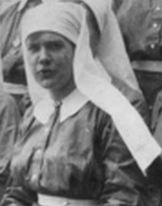
Embarked for France per 'Kanowna' 04 July 1916 from NSW
Part of a party of twenty Australian Red Cross nurses, sponsored by the NSW Jockey Club, and know as the 'Bluebirds' because of their blue uniforms.
Part of a party of twenty Australian Red Cross nurses, sponsored by the NSW Jockey Club, and know as the 'Bluebirds' because of their blue uniforms.
MORETON, Lettitia Gladys
|
Staff Nurse
AANS Born 1891 Brim, Vic. Daughter of Samuel Henry MORETON and Lettitia Dexter nee MILLEDGE Of Malvern Victoria Occupation prior to enlisting Nurse Trained at Bethesda Hospital Ballarat from March 1909-April 1914 Enlisted 1915 Embarked 17 July 1915 from Melbourne per ‘Orsovia’ Aged 24 Served in Quetta, India Died of Enteric Fever on 11 November 1916 Buried Quetta Govt. Cemetery Commemorated Delhi Memorial (India Gate) India Punch Thursday 29 July 1915 page 21 |
MOREY, Evelyn Rose
|
Staff Nurse
AANS Born 1883 in Pembroke, Tasm. Daughter of Abraham MOREY and Ellen Mary nee MITCHELLMORE Enlisted 23 October 1917 at Austins Ferry, Tas. Embarked 21 November 1917 from Melbourne per ‘Nestor’ Aged 32 years Served in England Returned to Australia 15 December 1919 per ‘Nestor’ Appointment Terminated 25 February 1920 Did not marry Awarded MBE Died 18 January 1953 in Hobart, Tas. Aged 69 years Late Matron Lachlan Park Hospital, Tas. Buried Cornelian Bay Cemetery (no listing in cemetery records) |
Nurse Miss Evelyn Rose Morey M.B.E
Evelyn Morey when awarded OBE for distinguished nursing service.
About the same time as Millbrook Rise opened in 1934 Matron Jane Power M.B.E handed in her resignation from the position of Matron. Miss Evelyn Rose Morey AANS (pictured left) was then appointed as Matron of Mental Diseases Hospital New Norfolk and served the institution for 18 years.
Photograph courtesy of Fran Read
The Mercury – Dated 28th April 1934 Reported:
APPOINTMENTS HOBART, Friday. At a meeting of the Executive Council today Miss Evelyn Rose Morey was promoted from the position of
sub-matron to that of matron at the Mental Diseases Hospital at New Norfolk.
Matron Morey witnessed the large construction process that saw the destruction of many old building on the west side of the Lachlan River and construction of the new east hospital, but she wasn’t just a bystander, she was called as a witness before J. H Chamberlain in 1949, who chaired the Parliamentary Standing Committee, looking at the need to have a new hospital and a segregated model that serves people with intellectual disabilities on one side of the hospital and people with mental health issues on the other. Plans were submitted for the construction of a new hospital at the cost of 1,500,000 pounds.
Nurse Evelyn Rose Morey AANS was born in Triabunna, Tasmania on the 2nd of April 1885 and trained at Lyell District Hospital for 5 years.
She enlisted on the 17 September 1917 and joined AANS 17 October 1917 aged 32. She embarked AMATS Nestor on the 21 November 1917 and disembarked at Southampton on the 18 January 1918. She took up her post as staff nurse in the 2nd Aust. Aux. Hospital, Southall 19 January 1918, staff nurse at 3rd Aust. Aux. Hospital Dartford 4 February 1918 and staff nurse at 1st Aust Gen Hospital Sutton Veny, 19 October 1919.
She returned to Australia 1 November 1919 per Nestor because she had an injured knee during a fall on the ship, Grace Darling on 7 January 1920 and was recommended “unfit” for general service by the 26 January 1920. Her service was terminated on the 25 February 1920 due to “demobilisation”. Evelyn Rose Morey MBE
TREASURED COIN SOVEREIGN THAT WAS NOT WANTED (Newspaper clipping)
A sovereign with an interesting history was among the articles disposed of in competitions at a fair held at New Norfolk on Saturday in aid of the Crippled Children’s Fund. The Sovereign, which was donated by the matron of
Lachlan Park Hospital (Sister Evelyn Morey) brought 8 pounds 15 shillings.
With nine others it was taken to France during the Great War by Sister Morey, and when a shop assistant refused to accept it in payment for a pair of gloves in a French shop, the coin was kept as a treasure. That the novelty
of gaining possession of a sovereign appealed to a great many was indicated by the amount collected for it on Saturday.
http://www.willowcourttasmania.org/2013/12/26/nurse-miss-evelyn-rose-morey-m-b-e/
Former Matron Of Lachlan Park Dead
Sister Evelyn Morey, who served as matron at the Lachlan Park Hospital, New Norfolk, for 18 years, died at a private hospital, Hobart, yesterday, after a long illness.
She was a daughter of the late Mr. and Mrs. Abraham Morey, of Okehampton, Triabunna.
Two years ago Sister Morey was awarded the M.B.E. for her work for the welfare of the mentally sick. She retired last year. She was aged 69.
Sister Morey served as a sister in the First World War, and was in England when the war ended.
She first joined the staff of Lachlan Park Hospital in 1923, but left for a number of years and returned in 1933.
She had an unbroken record of 20 years on the staff.
Her funeral will leave from Hooper and Burgess' parlours, Hobart, at 3.15 p.m. tomorrow.
The Mercury Monday 19 January 1953 page 7
Evelyn Morey when awarded OBE for distinguished nursing service.
About the same time as Millbrook Rise opened in 1934 Matron Jane Power M.B.E handed in her resignation from the position of Matron. Miss Evelyn Rose Morey AANS (pictured left) was then appointed as Matron of Mental Diseases Hospital New Norfolk and served the institution for 18 years.
Photograph courtesy of Fran Read
The Mercury – Dated 28th April 1934 Reported:
APPOINTMENTS HOBART, Friday. At a meeting of the Executive Council today Miss Evelyn Rose Morey was promoted from the position of
sub-matron to that of matron at the Mental Diseases Hospital at New Norfolk.
Matron Morey witnessed the large construction process that saw the destruction of many old building on the west side of the Lachlan River and construction of the new east hospital, but she wasn’t just a bystander, she was called as a witness before J. H Chamberlain in 1949, who chaired the Parliamentary Standing Committee, looking at the need to have a new hospital and a segregated model that serves people with intellectual disabilities on one side of the hospital and people with mental health issues on the other. Plans were submitted for the construction of a new hospital at the cost of 1,500,000 pounds.
Nurse Evelyn Rose Morey AANS was born in Triabunna, Tasmania on the 2nd of April 1885 and trained at Lyell District Hospital for 5 years.
She enlisted on the 17 September 1917 and joined AANS 17 October 1917 aged 32. She embarked AMATS Nestor on the 21 November 1917 and disembarked at Southampton on the 18 January 1918. She took up her post as staff nurse in the 2nd Aust. Aux. Hospital, Southall 19 January 1918, staff nurse at 3rd Aust. Aux. Hospital Dartford 4 February 1918 and staff nurse at 1st Aust Gen Hospital Sutton Veny, 19 October 1919.
She returned to Australia 1 November 1919 per Nestor because she had an injured knee during a fall on the ship, Grace Darling on 7 January 1920 and was recommended “unfit” for general service by the 26 January 1920. Her service was terminated on the 25 February 1920 due to “demobilisation”. Evelyn Rose Morey MBE
TREASURED COIN SOVEREIGN THAT WAS NOT WANTED (Newspaper clipping)
A sovereign with an interesting history was among the articles disposed of in competitions at a fair held at New Norfolk on Saturday in aid of the Crippled Children’s Fund. The Sovereign, which was donated by the matron of
Lachlan Park Hospital (Sister Evelyn Morey) brought 8 pounds 15 shillings.
With nine others it was taken to France during the Great War by Sister Morey, and when a shop assistant refused to accept it in payment for a pair of gloves in a French shop, the coin was kept as a treasure. That the novelty
of gaining possession of a sovereign appealed to a great many was indicated by the amount collected for it on Saturday.
http://www.willowcourttasmania.org/2013/12/26/nurse-miss-evelyn-rose-morey-m-b-e/
Former Matron Of Lachlan Park Dead
Sister Evelyn Morey, who served as matron at the Lachlan Park Hospital, New Norfolk, for 18 years, died at a private hospital, Hobart, yesterday, after a long illness.
She was a daughter of the late Mr. and Mrs. Abraham Morey, of Okehampton, Triabunna.
Two years ago Sister Morey was awarded the M.B.E. for her work for the welfare of the mentally sick. She retired last year. She was aged 69.
Sister Morey served as a sister in the First World War, and was in England when the war ended.
She first joined the staff of Lachlan Park Hospital in 1923, but left for a number of years and returned in 1933.
She had an unbroken record of 20 years on the staff.
Her funeral will leave from Hooper and Burgess' parlours, Hobart, at 3.15 p.m. tomorrow.
The Mercury Monday 19 January 1953 page 7
MORGAN-JONES, Enid Rose
|
Sister
AANS Born 31 March 1892 in Cheltenham, England Daughter of Reverent David MORGAN-JONES and Ada Hester nee FULLER Of St Colombs Rectory, Clayfield, Brisbane, Queensland Occupation prior to enlisting Nurse Enlisted 28 May 1917 Embarked 9 June 1917 from Sydney per ‘Mooltan’ Aged 25 years Served in Salonika & England Returned to Australia 9 August 1919 per ‘Miltiades’ Appointment Terminated 8 September 1919 Married Bishop Horace Henry DIXON Died 06 October 1968 in Qld. Aged 76 years Buried 68 in Pinnaroo Lawn Cemetery 4ANZ-184 |
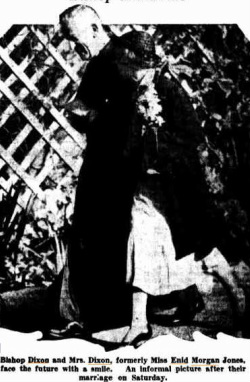
BISHOP DIXON TO WED
BRIDE MISS ENID MORGAN JONES
BISHOP H. H. Dixon, Coadjutor Bishop of Brisbane, and Miss Enid Morgan Jones will be
married next Saturday.
Miss Morgan Jones is a daughterof the Rev. D. Morgan Jones, formerly rector of Clayfield,
and later Hospital Chaplain to the Archbishop. In common with her sister, Miss Vera
Morgan Jones, she served in the war as an army nurse. Since her return she has devoted
herself to art, and was for a time a member of theteaching staff of the Technical College.
She is now on the staff of the Teachers' Training College. Bishop Dixon was born in
Cambridge, and educated at Cambridge University. He was ordained deacon in St.
Alban's Abbey, and became a priest in 1894.
SCHOOL FOUNDER Queensland knew him first when he became founder and headmaster
of The Southport School in 1901, a position he held with distinction until 1929. No gathering
of old South-portonians is well and truly met with-out their 'old head' telling many a merry
tale against himself, recalling the trials and triumphs associated with the building of a great
school, and with the training of young men destined to become valued citizens.
BRIDE MISS ENID MORGAN JONES
BISHOP H. H. Dixon, Coadjutor Bishop of Brisbane, and Miss Enid Morgan Jones will be
married next Saturday.
Miss Morgan Jones is a daughterof the Rev. D. Morgan Jones, formerly rector of Clayfield,
and later Hospital Chaplain to the Archbishop. In common with her sister, Miss Vera
Morgan Jones, she served in the war as an army nurse. Since her return she has devoted
herself to art, and was for a time a member of theteaching staff of the Technical College.
She is now on the staff of the Teachers' Training College. Bishop Dixon was born in
Cambridge, and educated at Cambridge University. He was ordained deacon in St.
Alban's Abbey, and became a priest in 1894.
SCHOOL FOUNDER Queensland knew him first when he became founder and headmaster
of The Southport School in 1901, a position he held with distinction until 1929. No gathering
of old South-portonians is well and truly met with-out their 'old head' telling many a merry
tale against himself, recalling the trials and triumphs associated with the building of a great
school, and with the training of young men destined to become valued citizens.
|
In more recent years the Church has had other calls to make on Bishop Dixon, and other honours to confer, but the welfare of the Southport School has always been dear to his heart. He became Archdeacon of Brisbane in 1930, and a year later Dean. He was consecrated Bishop in St. John's Cathedral in March, 1932, and on the death of Archbishop Sharp the following year he became Bishop Administrator of the Archdiocese. He has been Coadjutor Bishop since 1932.
Notwithstanding the demands of his many offices, Bishop Dixon has devoted considerable effort towards assisting social services. When Archbishop Wand came to Queensland Bishop Dixon was able to take a much-needed holiday trip to Britain, and returned much benefited in health. Bishop Dixon's first wife died in 1932. He has two sons. The Courier Mail Saturday 08 August 1936 page 15 |
|
There have been several interesting weddings during the week, but perhaps that which created most interest, though it was very quietly celebrated, was that of Bishop Dixon and Miss Enid Morgan Jones last Saturday. The ceremony took place in the chapel at Bishopsbourne at 8 o'clock in the morning, Archbishop Wand officiating. A frock of daffodil crepe romaine and three-quarter coat of brown with hat to match was chosen by the bride, who added a cluster of daffodils to her coat lapel, while the Bishop donned his: purple ecclesiastical robes. Miss Vera Morgan Jones attended her sister, and Rev. Archdeacon Stevenson attended the Bishop. After the ceremony Archbishopand Mrs. Wand entertained the wedding party, consisting of about a dozen guests, at breakfast.
Cairns Post Saturday 22 August 1936 page 10 Photograph Sunday Mail Brisbane Sudnay 16 August 1936 page 26 |
MORGAN-JONES, Vera Hester
Sister
AANS
Born Cheltenham England
Daughter of Reverend David MORGAN-JONES and Ada Hester nee FULER
Of St Colombs Rectory, Clayfield, Brisbane, Queensland
Occupation prior to enlisting Nurse
Enlisted 8 December 1916
Embarked 29 December 1919 from Sydney per ‘Themistocles’
Aged 25 years
Served in France
Returned to Australia 23 September 1919 per ‘Miltiades’
Discharged as medically unfit 29 May 1920
Married Harry Harold HAYMAN in 1941
Died 8 March 1962 in Qld.
AANS
Born Cheltenham England
Daughter of Reverend David MORGAN-JONES and Ada Hester nee FULER
Of St Colombs Rectory, Clayfield, Brisbane, Queensland
Occupation prior to enlisting Nurse
Enlisted 8 December 1916
Embarked 29 December 1919 from Sydney per ‘Themistocles’
Aged 25 years
Served in France
Returned to Australia 23 September 1919 per ‘Miltiades’
Discharged as medically unfit 29 May 1920
Married Harry Harold HAYMAN in 1941
Died 8 March 1962 in Qld.
MORIARTY, Aileen
Sister
Queen Alexandra's Imperial Military Nursing Service Reserve
Born 29 March 1876 in Terry, Ireland
Trained at Brisbane General Hospital, Qld. 1894 - 1898
Employed at Croydon District Hospital, Brisbane - Matron 1898 - 1900
Employed Women's Infirmary, Melbourne Vic. 1 year
Employed Mena House Nursing Home, Simpson Street, East Melbourne, Vic. - Matron and Sister
Employed Queens Home, Rose Park, Adelaide. SA
Enlisted 27 May 1915
Served 3 years and 293 days
Posted at Royal Victoria Hospital, Netley
Demobilised 16 March 1919
Queen Alexandra's Imperial Military Nursing Service Reserve
Born 29 March 1876 in Terry, Ireland
Trained at Brisbane General Hospital, Qld. 1894 - 1898
Employed at Croydon District Hospital, Brisbane - Matron 1898 - 1900
Employed Women's Infirmary, Melbourne Vic. 1 year
Employed Mena House Nursing Home, Simpson Street, East Melbourne, Vic. - Matron and Sister
Employed Queens Home, Rose Park, Adelaide. SA
Enlisted 27 May 1915
Served 3 years and 293 days
Posted at Royal Victoria Hospital, Netley
Demobilised 16 March 1919
MORONEY, Dorothy Una
Sister
AANS
Born Colac, Victoria
Daughter of Margaret MORONEY
Of Lilydale, Victoria
Occupation prior to enlisting Nurse
Enlisted 22 August 1916
Embarked 28 August 1916 from Melbourne per ‘Mooltan’
Aged 30 years
Served at Salonika
Returned to Australia 22 January 1919 per ‘Leicestershire’
Appointment Terminated 1 March 1919
Did not marry
Died 19 April 1949
Buried Springvale Botanical Cemetery Tristania Garden F4 Bed 16 Rose 24
SISTER DOROTHY MORONEY A.A.N.S.
Late of Lilydale
We are pleased to be in a position to publish extracts from letters received from one of our own girls, now on active service with the Mediterranean Expeditionary Forces in Salonika, Sister Dorothy Moroney, A.A.N.S. The present letters were dispatched during the voyage from India, and the first is from Aden. "But I must begin with our visit to Aden.which appears to be nothing but an impregnable rock, most uninviting, with no growth, not even a blade of grass. Well, we took gharris, the most dilapidated conveyances I have ever beheld, and when we got in they swayed and rocked in a most alarming manner. The harness was all tied together with pieces of string, and the horses were the most pitiable objects'. However afterwards, we were able to hire taxis and drove out to the only spot of interest some very old tank, very wonderfully built in the solid rock to save any rainwater which falls only about once a year, and which has to be carted to the town by camel teams. 'They were built centuries ago and historians have been unable to identify by what race of people. The whole place is a military centre, and I must not say too much about it. We returned to the 'Malwa' for afternoon tea and oh! the different atmosphere on board here to the boat in which we left Australian twelve months ago. Then the other passengers seemed to resent military nurses even travelling in the first saloon, whereas here no one can do enough for our entertainment and out little party really has the jolliest time. It's a lazy life, but "oh! so restful. Yesterday, as you know, was my birthday, and when I woke I discovered presents from a lot of the girls all over my cabin, and when I went to afternoon tea, a beautiful cake was on the table with roses and fruit and inscribed "A happy birthday" Really they are all very good to me. After dinner, we had a dance till 11, then supper on deck and impromptu speeches. It was really beautiful - the most brilliant moon light - as clear as day - and such a glorious light, and the bluest of blue skies, and just a ripple on the water. I think the girls were all trying to keep me from thinking of home. We had a gymkahana on board the other day, and derived a good deal of fun from it, and in the evening they gave us a dinner party and some very nice things were said of us, and we were toasted with the usual songs. Then we danced until 10.30 in the glorious moonlight. I wonder where we shall go, and what will become of us. It is such an extraordinary feeling to know nothing, for under ordinary circumstances we should have it all cut and dried, and stick to it unless some un-forseen thing occurred; whereas now we are simply disposed of by others. It makes one feel rather a cypher. Well, at 11 am the other day, a wireless message was received with orders to disembark at Suez. There was great gloom, as we had hoped to have gone closer to the front lines. However, we flew round and finished packing, and were the only passengers to leave the boat. Those remaining on board lined the rails and gave us a great send off, which rather affected some of us. We landed at Port Tuelig, and invaded the only hotel for afternoon tea; we eventually boarded the train for Alexandria - a ghastly journey of eleven hours; five in a very small compartment, and no sleepers. The rails run parallel to the Canal for some miles, and we passed the 'Malwa' en route, and there was much waving. Oh! the fascination of it all - and the coloring - quite different from India. The sunset behind the desert! Oh, the colors, and that beautiful golden and pink light that one sees in the pictures of the places, and the tall palms, and the donkeys, and camels, while the Arabs in their gowns and hoods look as though they had just stepped out of the Bible. The irrigation of course, is marvellous, and it is wonderful to see that part of the desert on one side of the line that is irrigable 'blossoming like the rose; and on the other side nothing but an illimitable stretch of golden sand. At several stations we saw; Australian hats, so we hung out and ''coo-eed,"which of course, brought them, along, and it was lovely to see them. We had a shocking night journey, but when one of the others would say 'What sort of a time are the boys having" and then there would be no more complaints. Well, we arrived at Alexandria about 6 am and drove to the Khedival Hostel, which was originally an Egyptian prince's palace: then a hotel; and now it is a home from stray army nurses, and there are literally swarms and swarms of them, and nothing else to break the monotony. There are sufficient notices posted on the bedroom doors to paper a house and break any ordinary girl's heart, if she tried to keep them. "
Now, here I am in Cairo, where we were instructed to proceed to a nurses' club, but having had some at Alexandria, we decided to put up at the Grand Continental, which, though it is not Shepherd's is quite good enough for me. The best hotels suit me down to the ground, but one thing we miss is the lack of electric fans. We never sat a minute in India without a fan being switched on. Now, everybody has said how dirty Cairo was, but compared to Bombay it is almost beautifully clean. Well of course, the first thing was the Pyramids, and as someone had told us not to miss the zoo, which is on the way, we called at the zoo. Of all the places in the world that I despise commend me to a zoo. We went in side and walked about 20 yards, and could see nothing! We expected beautiful gardens, but could only see beasts in cages, so I said 'If anyone expects me to wander round here in the heat looking at wild beasts - well, they're mad. and as the others were bored too, we came out and had afternoon tea at an awful little roadside cafe, and then took the tram for the Pyramids along a magnificent road lined on either side by huge shady trees, and were quite affected by the first glimpses we had of the Pyramids. We each took a camel to go round them, and oh! the mounting of the brutes. Of course, they lie down till you get on, and then three lurching movements and there you are- mountains high. How we laughed! The natives have picked up a lot of Australian slang, and one who posed as a guide said, when I told him I did not require a guide, I'm not an ordinary guide, Sister: I'm the dinkum Moses, and when he saw I meant it, he remarked 'Nothin' doin' and went off. When we made our camels trot, I wish you could have seen us. The shops here are really splendid, and din't we revel in them. We spent our money freely, but it is the only pretence of furlough I have had for years, so I did not mind, but thoroughly enjoyed it. One morning we spent in the 'Mouskie' as they call the bazaar here - a most fascinating place, and glorious things to buy. The Persian rugs were dreams, but everything is much dearer than in India. We met three Australian boys in one shop buying silk and being taken down so we went to their rescue. They were down from Palestine on furlough, and there are swarms of them. It gladdened our hearts to see them, when we had not seen any of 'our' boys for ages. Really, when one see's them among other men it makes one feel proud of them; 'they are a strong, manly lot, of fellows.. Oh! they're some' boys, I tell you. Well, the three we rescued asked if they might call and take us to afternoon tea, and, receiving permission, cafe with two cars the following day, and drove us 26 miles to the Barrage - a system of lochs and weirs that controls the whole irrigation system of the Nile. It is a most interesting and beautiful place; with splendid lawns and lovely shady trees; then we had a drive home in the cool of the evening. We all thoroughly appreciated it. We expected to be sent forward today, but seventy others have gone and the Indian Unit has been kept back. Palestine may be our destination, and as all the British troops have been transferred from a place we were expecting to go to, none of us is complaining. It is seven weeks now since I had any letters. I think if I do not received a batch when I reach my destination (where-ever it is) I shall go mad. You will, of course, received my letters very irregularly, but you are not to worry, as the mails are only being dispatched very casually, but I shall post every week on the off chance."
The Lilydale Express Friday 12 October 1917 page 3
AANS
Born Colac, Victoria
Daughter of Margaret MORONEY
Of Lilydale, Victoria
Occupation prior to enlisting Nurse
Enlisted 22 August 1916
Embarked 28 August 1916 from Melbourne per ‘Mooltan’
Aged 30 years
Served at Salonika
Returned to Australia 22 January 1919 per ‘Leicestershire’
Appointment Terminated 1 March 1919
Did not marry
Died 19 April 1949
Buried Springvale Botanical Cemetery Tristania Garden F4 Bed 16 Rose 24
SISTER DOROTHY MORONEY A.A.N.S.
Late of Lilydale
We are pleased to be in a position to publish extracts from letters received from one of our own girls, now on active service with the Mediterranean Expeditionary Forces in Salonika, Sister Dorothy Moroney, A.A.N.S. The present letters were dispatched during the voyage from India, and the first is from Aden. "But I must begin with our visit to Aden.which appears to be nothing but an impregnable rock, most uninviting, with no growth, not even a blade of grass. Well, we took gharris, the most dilapidated conveyances I have ever beheld, and when we got in they swayed and rocked in a most alarming manner. The harness was all tied together with pieces of string, and the horses were the most pitiable objects'. However afterwards, we were able to hire taxis and drove out to the only spot of interest some very old tank, very wonderfully built in the solid rock to save any rainwater which falls only about once a year, and which has to be carted to the town by camel teams. 'They were built centuries ago and historians have been unable to identify by what race of people. The whole place is a military centre, and I must not say too much about it. We returned to the 'Malwa' for afternoon tea and oh! the different atmosphere on board here to the boat in which we left Australian twelve months ago. Then the other passengers seemed to resent military nurses even travelling in the first saloon, whereas here no one can do enough for our entertainment and out little party really has the jolliest time. It's a lazy life, but "oh! so restful. Yesterday, as you know, was my birthday, and when I woke I discovered presents from a lot of the girls all over my cabin, and when I went to afternoon tea, a beautiful cake was on the table with roses and fruit and inscribed "A happy birthday" Really they are all very good to me. After dinner, we had a dance till 11, then supper on deck and impromptu speeches. It was really beautiful - the most brilliant moon light - as clear as day - and such a glorious light, and the bluest of blue skies, and just a ripple on the water. I think the girls were all trying to keep me from thinking of home. We had a gymkahana on board the other day, and derived a good deal of fun from it, and in the evening they gave us a dinner party and some very nice things were said of us, and we were toasted with the usual songs. Then we danced until 10.30 in the glorious moonlight. I wonder where we shall go, and what will become of us. It is such an extraordinary feeling to know nothing, for under ordinary circumstances we should have it all cut and dried, and stick to it unless some un-forseen thing occurred; whereas now we are simply disposed of by others. It makes one feel rather a cypher. Well, at 11 am the other day, a wireless message was received with orders to disembark at Suez. There was great gloom, as we had hoped to have gone closer to the front lines. However, we flew round and finished packing, and were the only passengers to leave the boat. Those remaining on board lined the rails and gave us a great send off, which rather affected some of us. We landed at Port Tuelig, and invaded the only hotel for afternoon tea; we eventually boarded the train for Alexandria - a ghastly journey of eleven hours; five in a very small compartment, and no sleepers. The rails run parallel to the Canal for some miles, and we passed the 'Malwa' en route, and there was much waving. Oh! the fascination of it all - and the coloring - quite different from India. The sunset behind the desert! Oh, the colors, and that beautiful golden and pink light that one sees in the pictures of the places, and the tall palms, and the donkeys, and camels, while the Arabs in their gowns and hoods look as though they had just stepped out of the Bible. The irrigation of course, is marvellous, and it is wonderful to see that part of the desert on one side of the line that is irrigable 'blossoming like the rose; and on the other side nothing but an illimitable stretch of golden sand. At several stations we saw; Australian hats, so we hung out and ''coo-eed,"which of course, brought them, along, and it was lovely to see them. We had a shocking night journey, but when one of the others would say 'What sort of a time are the boys having" and then there would be no more complaints. Well, we arrived at Alexandria about 6 am and drove to the Khedival Hostel, which was originally an Egyptian prince's palace: then a hotel; and now it is a home from stray army nurses, and there are literally swarms and swarms of them, and nothing else to break the monotony. There are sufficient notices posted on the bedroom doors to paper a house and break any ordinary girl's heart, if she tried to keep them. "
Now, here I am in Cairo, where we were instructed to proceed to a nurses' club, but having had some at Alexandria, we decided to put up at the Grand Continental, which, though it is not Shepherd's is quite good enough for me. The best hotels suit me down to the ground, but one thing we miss is the lack of electric fans. We never sat a minute in India without a fan being switched on. Now, everybody has said how dirty Cairo was, but compared to Bombay it is almost beautifully clean. Well of course, the first thing was the Pyramids, and as someone had told us not to miss the zoo, which is on the way, we called at the zoo. Of all the places in the world that I despise commend me to a zoo. We went in side and walked about 20 yards, and could see nothing! We expected beautiful gardens, but could only see beasts in cages, so I said 'If anyone expects me to wander round here in the heat looking at wild beasts - well, they're mad. and as the others were bored too, we came out and had afternoon tea at an awful little roadside cafe, and then took the tram for the Pyramids along a magnificent road lined on either side by huge shady trees, and were quite affected by the first glimpses we had of the Pyramids. We each took a camel to go round them, and oh! the mounting of the brutes. Of course, they lie down till you get on, and then three lurching movements and there you are- mountains high. How we laughed! The natives have picked up a lot of Australian slang, and one who posed as a guide said, when I told him I did not require a guide, I'm not an ordinary guide, Sister: I'm the dinkum Moses, and when he saw I meant it, he remarked 'Nothin' doin' and went off. When we made our camels trot, I wish you could have seen us. The shops here are really splendid, and din't we revel in them. We spent our money freely, but it is the only pretence of furlough I have had for years, so I did not mind, but thoroughly enjoyed it. One morning we spent in the 'Mouskie' as they call the bazaar here - a most fascinating place, and glorious things to buy. The Persian rugs were dreams, but everything is much dearer than in India. We met three Australian boys in one shop buying silk and being taken down so we went to their rescue. They were down from Palestine on furlough, and there are swarms of them. It gladdened our hearts to see them, when we had not seen any of 'our' boys for ages. Really, when one see's them among other men it makes one feel proud of them; 'they are a strong, manly lot, of fellows.. Oh! they're some' boys, I tell you. Well, the three we rescued asked if they might call and take us to afternoon tea, and, receiving permission, cafe with two cars the following day, and drove us 26 miles to the Barrage - a system of lochs and weirs that controls the whole irrigation system of the Nile. It is a most interesting and beautiful place; with splendid lawns and lovely shady trees; then we had a drive home in the cool of the evening. We all thoroughly appreciated it. We expected to be sent forward today, but seventy others have gone and the Indian Unit has been kept back. Palestine may be our destination, and as all the British troops have been transferred from a place we were expecting to go to, none of us is complaining. It is seven weeks now since I had any letters. I think if I do not received a batch when I reach my destination (where-ever it is) I shall go mad. You will, of course, received my letters very irregularly, but you are not to worry, as the mails are only being dispatched very casually, but I shall post every week on the off chance."
The Lilydale Express Friday 12 October 1917 page 3
MORPHETT, Ella Blanch
|
Sister
AANS Born 22 February 1883 at Clarendon, SA Daughter of Henry MORPHETT and Rebecca nee EISEMANN Of Clarendon, South Australia Occupation prior to enlisting Nurse Trained 3 years Adelaide Hospital Enlisted 29 July 1915 Embarked 17 July 1915 from Melbourne per ‘Orsova’ Aged 32 years Sea Transport on duty on Orsova & Themistocles hospital ships Also served in England Returned to Australia 15 August 1919 per ‘Norman’ Appointment Terminated 21 June 1920 Married 1928 Johannes Andreas Olsen SOLTVEDT in Qld. Surname changed to OLSEN Ella Blanche Olsen died 5 February 1964 Aged 82 years Buried Cheltenham Cemetery, SA |
MORPHETT, Grace Evelyn
Nurse
Born 18 May 1892 at Evandale, SA
Daughter of John Ernest MORPHETT and Ada Bertha Webb nee FRY
Resided Kings Park, SA
Aged 26 years
Married Alfred Harrald JAMES 29 April 1920 at Baptist Church, Knightsbridge, SA
Died 15 October 1974
Resided Lower Mitcham, SA
Cremated Centennial Park Cemetery
Born 18 May 1892 at Evandale, SA
Daughter of John Ernest MORPHETT and Ada Bertha Webb nee FRY
Resided Kings Park, SA
Aged 26 years
Married Alfred Harrald JAMES 29 April 1920 at Baptist Church, Knightsbridge, SA
Died 15 October 1974
Resided Lower Mitcham, SA
Cremated Centennial Park Cemetery
At a meeting of the Adelaide Hospital board on Monday Nurse Grace Evelyn Morphett was presented with the gold medal for having passed first class in the final examinations.
The Register Tuesday 24 September 1918 page 4
The Register Tuesday 24 September 1918 page 4
MORRICE, Nellie Constance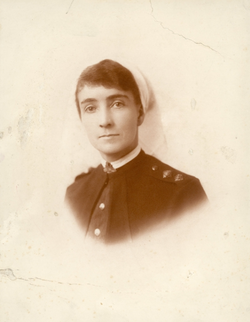
Sister
AANS 3rd Australian Auxillary Hospital Born 31 March 1881 at Sutton Forrest, NSW Daughter of David MORRICE and Sarah Mary nee HALE Of Sutton Forrest, NSW Trained at Royal Prince Alfred Hospital, Sydney Aged 32 years Enlisted 14 November 1914 Embarked 25 November 1914 Served in Egypt, London and France Returned to Australia 02 March 1919 per 'Demosthenes' Discharged as medically unfit 06 March 1919 Died 11 April 1963 at Chatswood, NSW Read more here www.awm.gov.au H16062 |

Awarded Royal Red Cross (2nd Class)
Date of Commonwealth of Australia Gazette: 7 November 1918
Location in Commonwealth of Australia Gazette: Page 2111, position 127
Date of London Gazette: 3 June 1918
Location in London Gazette: Page 6475, position 6
Date of Commonwealth of Australia Gazette: 7 November 1918
Location in Commonwealth of Australia Gazette: Page 2111, position 127
Date of London Gazette: 3 June 1918
Location in London Gazette: Page 6475, position 6
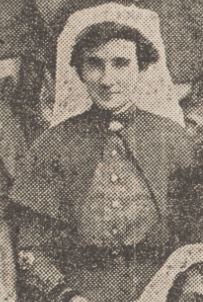
Among the names of recipients of the Royal Red Cross appearing in the Birthday honours on June 3, is that of Sister Nellie C Morrice, A.A.N.S. who was trained at the Royal Prince Alfred Hospital, and was a member of the A.A.N.S. prior to the war. She volunteered for service immediately on the outbreak of war, and left Australia in November 1914, with No 2 A.G.H. After service at Mena, Ghezirch, Lemnos and Ismalia she was transferred to England, and then to No 2 A.G.H. at Abbeville. She is now sub-matron of the No 25 British General Hospital at Hardelot, near Boulogne. Sister Morrice is a daughter of Mr. and Mrs. David Morrice of Ealing Forest, Sutton Forest, who in addition have three sons on active service.
Sydney Morning Herald
Thursday 29 August 1918 page 8
Sydney Morning Herald
Thursday 29 August 1918 page 8
www.awm.gov.au
P10245.003
FOR WOMEN.
BUSH NURSING.
Prominent among the agencies that are assisting settlement on the land 1B the Bush Nursing Association. Women would perhaps give it pride of place, for it is they who are most affected and most concerned with the problem of preserving and caring for the health ot the family.
There are 35 bush nursing centres in the State. Fully qualified nurses, holding both general and obstetric certificates (and some nurses hold a third, that of the Tresillian Training School), are stationed at each centre. They are stationed mostly in remote rural districts, and take thelr part in the campaign to improve the health of the nation by spreading a knowledge of the laws of health. The bush nurse also works in conjunction with the Education Department, and visits schools in the district to give the children simple lectures on first-aid, home nursing, and personal hygiene.
The secretary of the Bush Nursing Association, Miss Morrice, is a trainee of the Royal Prince Alfred Hospital and the Royal Hospital for Women, Sydney. Miss Morrice had a long war service. She went away with the first hospital ship in 1914, and did continuous service with the Army, being still on duty when the Armistice was signed. Miss Morrice served in Egypt, Lemnos, England, and France, and was awarded the Royal Red Cross in 1918.
Sydney Morning Herald Wednesday 10 March 1926 page 10
P10245.003
FOR WOMEN.
BUSH NURSING.
Prominent among the agencies that are assisting settlement on the land 1B the Bush Nursing Association. Women would perhaps give it pride of place, for it is they who are most affected and most concerned with the problem of preserving and caring for the health ot the family.
There are 35 bush nursing centres in the State. Fully qualified nurses, holding both general and obstetric certificates (and some nurses hold a third, that of the Tresillian Training School), are stationed at each centre. They are stationed mostly in remote rural districts, and take thelr part in the campaign to improve the health of the nation by spreading a knowledge of the laws of health. The bush nurse also works in conjunction with the Education Department, and visits schools in the district to give the children simple lectures on first-aid, home nursing, and personal hygiene.
The secretary of the Bush Nursing Association, Miss Morrice, is a trainee of the Royal Prince Alfred Hospital and the Royal Hospital for Women, Sydney. Miss Morrice had a long war service. She went away with the first hospital ship in 1914, and did continuous service with the Army, being still on duty when the Armistice was signed. Miss Morrice served in Egypt, Lemnos, England, and France, and was awarded the Royal Red Cross in 1918.
Sydney Morning Herald Wednesday 10 March 1926 page 10
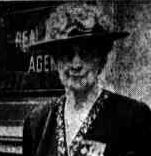
Bush Nursing Secretary Retires
AFTER 23 years of splendid service to the Bush Nursing Association, Sister Nellie Morrice, O.B.E., R.R.C., general secretary, retired this week. In reviewing the work of the Association over the years, Sister Morrice said that while at the present time 31 branches were open, many centres remain closed owing lo shortage of nurses. 'It must never be forgotten that much of the success of the Bush Nursing Association was due to Lady Game,' said Sister Morrice. 'In addition to frequent visits to centres and her deep interest in their activities she was instrumental in raising money for It. I'As a result nf her work, we 'opened it
Centres and built a inumber of hospitals. Many of these hospitals were handed over to the Hospital Commission
as they outgrow the scope of the Bush Nursing Association. 'Sister Morrice paid a high tribute to the nurses.'
'They have done a wonderful Job,' she said. 'All are keenly intelligent women, interested in their work. The
manner in which they work against heavy odds, indicates they possess the spirit of the pioneers. The Bush
Nursing Council never falters in it's interest in country people. Its willingness to help is shown as soon as
committees show signs of helping themselves,' she said. Sister Morrice will be succeeded by Sister Russell.
The Farmer and Settler Friday 07 February 1947 page 14
Nellie Constance Morrice was born on the 31st of March 1881 in the small parish of Ealing Forest, near the town of Berrima, New South Wales, Australia. She was the seventh of eleven children (Emma, May, Arthur, Ethel, Muriel, Frank, Linda, John, Wilson and David) of Australian born parents David Morrice and Sarah Mary, nee Hale.
On November 1903, Nellie undertook training at Royal Prince Alfred Hospital in Sydney and qualified as a staff nurse in 1906. She gained her four year certificate in April 1907 passing with a ‘credit’. She did this with experience as a theatre, instruments nurse and a dispensary certificate.
After a midwifery course undertaken at the Royal Hospital for Women she nursed privately in the period of 1907-1909 and was a senior sister at Pines Private Hospital in Randwick. Then she returned back to the Royal Prince Alfred Hospital three years later becoming sister in charge of the Alexandra and Mary Roberts Wards in 1912.
Sister Morrice had joined the Australian Army Nursing Service in May of 1910. On the 21st of November 1914, Nellie enlisted in the Australian Imperial Force (A.I.F) and was appointed a staff nurse. She embarked in Kyarra on the 28th of November 1914.
While Nellie was stationed in South Africa she created a doll that was carefully dressed in a bespoke World War One nurse uniform which, she named ‘Sister Helen’. Which Nellie sent back to her niece back in Australia. This hand painted porcelain doll is now located in the Australian War Memorial exhibition titled ‘Nurses from Zululand to Afghanistan’.
Sister Morrice was awarded the Royal Red Cross (2nd class) ‘For her valuable service with the Army in France and Flanders’ on the 3rd of June 1918.
After the war, Nellie became the Matron if Georges Heights Military Hospital in Mosman. After this she was appointed sub matron at the Prince of Wales hospital in Randwick.
Later she was appointed secretary to the New South Wales (Lady Dudley’s) Bush Nursing Association, which mainly focused on midwifery and child health. In this position Nellie was responsible for donations, finances, the preparation and presentation of annual reports. In the year of 1926 Morrice represented New South Wales at an interstate bush nursing conference.
In 1948 Nellie retired having worked as a secretary for 24 of the then 37 years of the Bush Nursing Association, she was then elected a life member ‘by virtue and service and devotion’ and then lived in retirement at Chatswood.
Nellie Constance Morrice passed away on the 11th of April 1963 at her home, aged 82.
Nellie was a wonderful and highly acclaimed nurse in Australia and her hard work and dedication to the medical field will always be recognised and remembered.
Courtesy of Madeline Lockhart
AFTER 23 years of splendid service to the Bush Nursing Association, Sister Nellie Morrice, O.B.E., R.R.C., general secretary, retired this week. In reviewing the work of the Association over the years, Sister Morrice said that while at the present time 31 branches were open, many centres remain closed owing lo shortage of nurses. 'It must never be forgotten that much of the success of the Bush Nursing Association was due to Lady Game,' said Sister Morrice. 'In addition to frequent visits to centres and her deep interest in their activities she was instrumental in raising money for It. I'As a result nf her work, we 'opened it
Centres and built a inumber of hospitals. Many of these hospitals were handed over to the Hospital Commission
as they outgrow the scope of the Bush Nursing Association. 'Sister Morrice paid a high tribute to the nurses.'
'They have done a wonderful Job,' she said. 'All are keenly intelligent women, interested in their work. The
manner in which they work against heavy odds, indicates they possess the spirit of the pioneers. The Bush
Nursing Council never falters in it's interest in country people. Its willingness to help is shown as soon as
committees show signs of helping themselves,' she said. Sister Morrice will be succeeded by Sister Russell.
The Farmer and Settler Friday 07 February 1947 page 14
Nellie Constance Morrice was born on the 31st of March 1881 in the small parish of Ealing Forest, near the town of Berrima, New South Wales, Australia. She was the seventh of eleven children (Emma, May, Arthur, Ethel, Muriel, Frank, Linda, John, Wilson and David) of Australian born parents David Morrice and Sarah Mary, nee Hale.
On November 1903, Nellie undertook training at Royal Prince Alfred Hospital in Sydney and qualified as a staff nurse in 1906. She gained her four year certificate in April 1907 passing with a ‘credit’. She did this with experience as a theatre, instruments nurse and a dispensary certificate.
After a midwifery course undertaken at the Royal Hospital for Women she nursed privately in the period of 1907-1909 and was a senior sister at Pines Private Hospital in Randwick. Then she returned back to the Royal Prince Alfred Hospital three years later becoming sister in charge of the Alexandra and Mary Roberts Wards in 1912.
Sister Morrice had joined the Australian Army Nursing Service in May of 1910. On the 21st of November 1914, Nellie enlisted in the Australian Imperial Force (A.I.F) and was appointed a staff nurse. She embarked in Kyarra on the 28th of November 1914.
While Nellie was stationed in South Africa she created a doll that was carefully dressed in a bespoke World War One nurse uniform which, she named ‘Sister Helen’. Which Nellie sent back to her niece back in Australia. This hand painted porcelain doll is now located in the Australian War Memorial exhibition titled ‘Nurses from Zululand to Afghanistan’.
Sister Morrice was awarded the Royal Red Cross (2nd class) ‘For her valuable service with the Army in France and Flanders’ on the 3rd of June 1918.
After the war, Nellie became the Matron if Georges Heights Military Hospital in Mosman. After this she was appointed sub matron at the Prince of Wales hospital in Randwick.
Later she was appointed secretary to the New South Wales (Lady Dudley’s) Bush Nursing Association, which mainly focused on midwifery and child health. In this position Nellie was responsible for donations, finances, the preparation and presentation of annual reports. In the year of 1926 Morrice represented New South Wales at an interstate bush nursing conference.
In 1948 Nellie retired having worked as a secretary for 24 of the then 37 years of the Bush Nursing Association, she was then elected a life member ‘by virtue and service and devotion’ and then lived in retirement at Chatswood.
Nellie Constance Morrice passed away on the 11th of April 1963 at her home, aged 82.
Nellie was a wonderful and highly acclaimed nurse in Australia and her hard work and dedication to the medical field will always be recognised and remembered.
Courtesy of Madeline Lockhart
MORRIS, Alice Henrietta Jane (Hetty)
|
Sister
AANS Born 1879 at Echuca, Vic. Daughter of Alonzo Ephriam MORRIS and Annie nee ANDREWS Of 16 Cromwell St, Caulfield, Victoria Occupation prior to enlisting Nurse 3 years Queen Victoria Hospital Enlisted 4 August 1915 Embarked 4 August 1915 from Melbourne per ‘Orontes’ Aged 36 years Served in England & France Returned to Australia 1 November 1919 per ‘Berrima’ Appointment Terminated 1 February 1920 Did not marry Died 17 July 1953 in Melbourne, Vic. Buried Springvale Botanical Cemetery Meleleuca Garden M5 Bed 3 Rose 01 Photograph Table Talk Thursday 16 September 1915 page 26 |
MORRIS, Annie Rebecca
Staff Nurse
AANS
Born 08 March 1892 at Yatala (Rosewater), South Australia
Daughter of David MORRIS and Catherine nee HILL
Of Falcon St, West Adelaide, South Australia
Occupation prior to enlisting: Nurse
Trained 3 years Broken Hill Hospital
Enlisted 19 November 1917
Embarked 29 November 1917 from Adelaide per ‘Indarra’
Aged 25 years
Served in Bombay India
Returned to Australia 26 February 1919 per ‘Demostheris’
Appointment Terminated 18 April 1919
Married 1919 Eric Bennett GLUYAS in Broken Hill, NSW
Died 1982 in Melbourne, Vic.
Cremated Springvale Botanical Cemetery 06 August 1982 and ashes collected
AANS
Born 08 March 1892 at Yatala (Rosewater), South Australia
Daughter of David MORRIS and Catherine nee HILL
Of Falcon St, West Adelaide, South Australia
Occupation prior to enlisting: Nurse
Trained 3 years Broken Hill Hospital
Enlisted 19 November 1917
Embarked 29 November 1917 from Adelaide per ‘Indarra’
Aged 25 years
Served in Bombay India
Returned to Australia 26 February 1919 per ‘Demostheris’
Appointment Terminated 18 April 1919
Married 1919 Eric Bennett GLUYAS in Broken Hill, NSW
Died 1982 in Melbourne, Vic.
Cremated Springvale Botanical Cemetery 06 August 1982 and ashes collected
MORRIS, Clara
Nurse
British Red Cross
Born 1870 at St. Albans, Herefordshire
Daughter of John Hurst MORRIS and Emily nee CLARK
Returning to Australia per 'Takada'
Embarked 25 December 1918 free passage in return for services
British Red Cross
Born 1870 at St. Albans, Herefordshire
Daughter of John Hurst MORRIS and Emily nee CLARK
Returning to Australia per 'Takada'
Embarked 25 December 1918 free passage in return for services
A NOTABLE WAR NURSE.
By FALAISE.
Among those who returned to Australiaby the s.s. Takada, which reached Melbourne on February 11, was Miss Clara Morris, a Queensland woman, who has had some stirring experiences in' the war stricken countries. Though a Queenslander, she came to Melbourne some years ago to learn nursing, and eventually graduated from the Women's Hospital. Later, she went to England for a holiday, and while she was there war was declared she offered her services to the British Red Cross, and was subsequently sent to Serbia, where she remained working in the hospital for three months after the Austrian army had taken possession. Both before and after the defeat of the Serbs, the conditions of living were very trying, the food problem being difficult to solve. At one time , only beans were available as food for two weeks. When the Austrian took possession they at once controlled the hospitals, and the nursing staff continued their duties, but instead of having German and Austrian prisoners as orderlies, these positions were then filled by Serbs. The army—some thousands strong—remained until the Serbian prisoners were all, evacuated, and then Sister Morris says she saw a memorable sight—the march out into the plains and across a defile of the huge Austro-Hungarian army. The uniforms of the men were, in butcher-blue, and bright brick red colouring, and made a vivid stream of colour against the snow-covered country. When, later, she was able to leave Serbia having been exchanged for an Austrian woman of high rank—she returned to England, but before long was on her way to Russia, and there was soon busily engaged at a hospital in Galicia. She was greatly struck by the gap which lies between the people of good birth and the peasants in that country. The one sectionshe considered to be among the most highly cultured she had met in her travels, as they were not only excellent linguists and well read on all subjects of international interest, but on the whole were musicians of merit. Their contrast with the poor country people was the more marked owing to this culture, for the peasant folk were not
only without the ordinary. rudiments of education, but were primitive in their methods of living, and to see them working in the field carried the observer back to stories of. the Bible which a peak of sowing grain. In Russia she saw men scattering their seed upon the ground from apron bags tied round their waists. Later in the year the poor grain so raised would be ground by hand with a large stone.
Altogether Sister Morris was in Russia for 15 months, and during that time was in Petrograd and other large cities. She had hardships to endure in the evacuation from Galicia, and considers the revolution in Russia as bad as, and probably worse than, the French revolution, for the rabble, have for the time triumphed. Some of the most eminent men and women have, in order to save their lives, joined the Bolsheviks, and it is no unusual thing to see grand dukes and duchesses doing menial work or trying to earn money by selling papers in the streets.
In the retreat from Russia Sister Morris and other Britishers were conveyed by armoured cars, and at times they were closely pressed by the enemy, for the roads were often difficult to traverse. At one time it took them three hours to cover 10 versts, ,which is less than 10 miles. When she at last reached England again, she found plenty of nursing to do there, and later when it was possible for her to be spared to return to Australia, she decided to come out with troops. Her departure was for a time delayed, as she suffered from influenza. Fortunately, however, she made a good recovery, and was able to embark on the Takada. The voyage was particularly enjoyable, as the conditions for living on this vessel were splendid, considering the limitations regarding, food supplies which now exist, in England.
Sister Morris has been honoured by four orders for her service. Two were gained in Serbia and two in Russia. Unfortunately, however, she now has only one in her possession, the others having been lost in the retreat from Russia. She is still on duty whilst on the troopship, and in Melbourne she was wearing the uniform of the British Red Cross. It is of navy blue material, and made quite simply in the style of a one-piece frock, with belt at waist. Dark red epaulettes and a small round collar, also pipings on the cuffs, give it a smart effect.
The Australasian Saturday 15 February 1919 page 34
By FALAISE.
Among those who returned to Australiaby the s.s. Takada, which reached Melbourne on February 11, was Miss Clara Morris, a Queensland woman, who has had some stirring experiences in' the war stricken countries. Though a Queenslander, she came to Melbourne some years ago to learn nursing, and eventually graduated from the Women's Hospital. Later, she went to England for a holiday, and while she was there war was declared she offered her services to the British Red Cross, and was subsequently sent to Serbia, where she remained working in the hospital for three months after the Austrian army had taken possession. Both before and after the defeat of the Serbs, the conditions of living were very trying, the food problem being difficult to solve. At one time , only beans were available as food for two weeks. When the Austrian took possession they at once controlled the hospitals, and the nursing staff continued their duties, but instead of having German and Austrian prisoners as orderlies, these positions were then filled by Serbs. The army—some thousands strong—remained until the Serbian prisoners were all, evacuated, and then Sister Morris says she saw a memorable sight—the march out into the plains and across a defile of the huge Austro-Hungarian army. The uniforms of the men were, in butcher-blue, and bright brick red colouring, and made a vivid stream of colour against the snow-covered country. When, later, she was able to leave Serbia having been exchanged for an Austrian woman of high rank—she returned to England, but before long was on her way to Russia, and there was soon busily engaged at a hospital in Galicia. She was greatly struck by the gap which lies between the people of good birth and the peasants in that country. The one sectionshe considered to be among the most highly cultured she had met in her travels, as they were not only excellent linguists and well read on all subjects of international interest, but on the whole were musicians of merit. Their contrast with the poor country people was the more marked owing to this culture, for the peasant folk were not
only without the ordinary. rudiments of education, but were primitive in their methods of living, and to see them working in the field carried the observer back to stories of. the Bible which a peak of sowing grain. In Russia she saw men scattering their seed upon the ground from apron bags tied round their waists. Later in the year the poor grain so raised would be ground by hand with a large stone.
Altogether Sister Morris was in Russia for 15 months, and during that time was in Petrograd and other large cities. She had hardships to endure in the evacuation from Galicia, and considers the revolution in Russia as bad as, and probably worse than, the French revolution, for the rabble, have for the time triumphed. Some of the most eminent men and women have, in order to save their lives, joined the Bolsheviks, and it is no unusual thing to see grand dukes and duchesses doing menial work or trying to earn money by selling papers in the streets.
In the retreat from Russia Sister Morris and other Britishers were conveyed by armoured cars, and at times they were closely pressed by the enemy, for the roads were often difficult to traverse. At one time it took them three hours to cover 10 versts, ,which is less than 10 miles. When she at last reached England again, she found plenty of nursing to do there, and later when it was possible for her to be spared to return to Australia, she decided to come out with troops. Her departure was for a time delayed, as she suffered from influenza. Fortunately, however, she made a good recovery, and was able to embark on the Takada. The voyage was particularly enjoyable, as the conditions for living on this vessel were splendid, considering the limitations regarding, food supplies which now exist, in England.
Sister Morris has been honoured by four orders for her service. Two were gained in Serbia and two in Russia. Unfortunately, however, she now has only one in her possession, the others having been lost in the retreat from Russia. She is still on duty whilst on the troopship, and in Melbourne she was wearing the uniform of the British Red Cross. It is of navy blue material, and made quite simply in the style of a one-piece frock, with belt at waist. Dark red epaulettes and a small round collar, also pipings on the cuffs, give it a smart effect.
The Australasian Saturday 15 February 1919 page 34
MORRIS, Gertrude D
RED CROSS AND WAR.
Returned Nurse From the Front Gives Thrilling Experience of the Balkan Conflict. EXTRAORDINARY RACES. Some of the units of the British Red Cross Society which were sent out to the Near East at the beginning of the Balkan war returned to England last month after serving in the hospitals and looking after the sick and wounded.
Among them is Miss Gertrude D. Morris who went out as a nurse to Montenegro last November with the Second Unit. " "In spite of their docility while in our charge. " she said, the Montenegrins are the most extraordinary race I have ever met. The one ambition of a Montenegrin is To CUT OFF THE-HEAD OF-A TURK He is not considered
to be a good citizen unless he had done this. The, wounded were never happy until they could get away to fight again. "They have been fighting the Turks for 400 years; fighting is their trade. and they seem to care about nothing else. The women do all the work of the country. You can see them trudging along for miles with
big packs on their backs. And yet the women are just as keen about fighting the Turks as the men. If a man Is a coward, and does not join the army, the women boycott him. "One of the first things I saw at Antievre was a man stalking along carrying an umbrella and his rifle, while his -wife walked dutifully behind carrying an immense tin trunk on her head. Almost every Montenegrin soldier carries an umbrella as well as a rifle. Most of the Albanians do the same. Another member of the British Red Cross Society who went to Montenegro was Mr. William D. Sheffield. "When the attack got near the hospital, he said. "all the patients in it rose at once and rushed out to help in repelling it; in spite of all that we could to stop them. "Our patients had a strong objection to amputations and some preferred to die rather than submit to them. They bore pain in a wonderful way. 'The percentage of death was very small; indeed, it may.be said that modern methods of treating the sick and wounded have robbed war of half its horrors. "After leaving Vilgari I was transferred back to Zorgan. On my way there I had to pass through
a place called Skla, and there I WAS MAROONED FOR TWO DAYS. It was a small village in Albania, and at the opening of the war the Albanians had cleared out and-taken everything away with them. "I was stuck there for two whole days and I was without food for the whole of the time, with the exception of one piece of black bread.
which I begged of a passing soldier. I pulled down a cupboard in a house to make a fire, and made myself as comfortable as I could. "At last I was taken off on a boat which was passing down Lake Skutari, conveying Prince Mirko on a tour of inspection at the Monte negrin positions round Scutari".
Globe Saturday 1 March 1913 page 7
Returned Nurse From the Front Gives Thrilling Experience of the Balkan Conflict. EXTRAORDINARY RACES. Some of the units of the British Red Cross Society which were sent out to the Near East at the beginning of the Balkan war returned to England last month after serving in the hospitals and looking after the sick and wounded.
Among them is Miss Gertrude D. Morris who went out as a nurse to Montenegro last November with the Second Unit. " "In spite of their docility while in our charge. " she said, the Montenegrins are the most extraordinary race I have ever met. The one ambition of a Montenegrin is To CUT OFF THE-HEAD OF-A TURK He is not considered
to be a good citizen unless he had done this. The, wounded were never happy until they could get away to fight again. "They have been fighting the Turks for 400 years; fighting is their trade. and they seem to care about nothing else. The women do all the work of the country. You can see them trudging along for miles with
big packs on their backs. And yet the women are just as keen about fighting the Turks as the men. If a man Is a coward, and does not join the army, the women boycott him. "One of the first things I saw at Antievre was a man stalking along carrying an umbrella and his rifle, while his -wife walked dutifully behind carrying an immense tin trunk on her head. Almost every Montenegrin soldier carries an umbrella as well as a rifle. Most of the Albanians do the same. Another member of the British Red Cross Society who went to Montenegro was Mr. William D. Sheffield. "When the attack got near the hospital, he said. "all the patients in it rose at once and rushed out to help in repelling it; in spite of all that we could to stop them. "Our patients had a strong objection to amputations and some preferred to die rather than submit to them. They bore pain in a wonderful way. 'The percentage of death was very small; indeed, it may.be said that modern methods of treating the sick and wounded have robbed war of half its horrors. "After leaving Vilgari I was transferred back to Zorgan. On my way there I had to pass through
a place called Skla, and there I WAS MAROONED FOR TWO DAYS. It was a small village in Albania, and at the opening of the war the Albanians had cleared out and-taken everything away with them. "I was stuck there for two whole days and I was without food for the whole of the time, with the exception of one piece of black bread.
which I begged of a passing soldier. I pulled down a cupboard in a house to make a fire, and made myself as comfortable as I could. "At last I was taken off on a boat which was passing down Lake Skutari, conveying Prince Mirko on a tour of inspection at the Monte negrin positions round Scutari".
Globe Saturday 1 March 1913 page 7
MORRIS, Olive Toulmin
Staff Nurse
AANS
Born 1877 at Dunolly, Vic.
Daughter of Edward Parker MORRIS and Agnes Campbell nee LOGAN
Repatriation contact on 22 June 1962 disclosed that no records were found at Central Army Records Office
Newspaper article Great Southern Star 15/1/1918 mentions Olive Morris heading off to war-she is a nurse at Woorayl Hospital, Leongatha, Victoria.
Electoral Roll 1914 shows Olive Toulmin Morris as a nurse in Leongatha.
Did not marry
Died 12 February 1970 in Vic.
Resided Glenhuntly, Vic.
Cremated 16 February 1970 at Springvale Botanical Cemetery and ashes collected
AANS
Born 1877 at Dunolly, Vic.
Daughter of Edward Parker MORRIS and Agnes Campbell nee LOGAN
Repatriation contact on 22 June 1962 disclosed that no records were found at Central Army Records Office
Newspaper article Great Southern Star 15/1/1918 mentions Olive Morris heading off to war-she is a nurse at Woorayl Hospital, Leongatha, Victoria.
Electoral Roll 1914 shows Olive Toulmin Morris as a nurse in Leongatha.
Did not marry
Died 12 February 1970 in Vic.
Resided Glenhuntly, Vic.
Cremated 16 February 1970 at Springvale Botanical Cemetery and ashes collected
MORRIS, Stella Marie
Staff Nurse
AANS
Born 26 January 1895 at Ballarat Victoria
Daughter of Michael james MORRIS and Mary Sophia nee BEIBY
Of Lyons St, Ballarat, Victoria
Occupation prior to enlisting Nurse
Enlisted 12 October 1918
Embarked 14 October 1918 from Sydney per ‘Wyreema’
Aged 23 years
Disembarked Fremantle WA
For Service at Quarantine Station Fremantle, WA
Returned home 28 January 1918 per ‘Wyreema’
Appointment Terminated 12 February 1919
Married Arthur Percival Robert WILLIS in 1920
Died 02 June 1985 at St. Kilda, Vic.
AANS
Born 26 January 1895 at Ballarat Victoria
Daughter of Michael james MORRIS and Mary Sophia nee BEIBY
Of Lyons St, Ballarat, Victoria
Occupation prior to enlisting Nurse
Enlisted 12 October 1918
Embarked 14 October 1918 from Sydney per ‘Wyreema’
Aged 23 years
Disembarked Fremantle WA
For Service at Quarantine Station Fremantle, WA
Returned home 28 January 1918 per ‘Wyreema’
Appointment Terminated 12 February 1919
Married Arthur Percival Robert WILLIS in 1920
Died 02 June 1985 at St. Kilda, Vic.
MORRIS, Sybil Grace
Staff Nurse
AANS
Born 1888 at Charters Towers, Qld.
Daughter of Emily Elizabeth SKEWES nee MORRIS
Mother married Martin SKEWES in 1896
Of Jackson St, Eagle Junction, Brisbane, Queensland
Occupation prior to enlisting: Nurse
Enlisted 5 April 1916
Embarked 29 December 1916 from Sydney per ‘Themistocles’
Aged 28 years
Served in France & England
Returned to Australia 22 May 1918
Appointment Terminated 25 June 1918
Sybil married Thomas Charles CLARKE in 1919
She died in Queensland in 1980
AANS
Born 1888 at Charters Towers, Qld.
Daughter of Emily Elizabeth SKEWES nee MORRIS
Mother married Martin SKEWES in 1896
Of Jackson St, Eagle Junction, Brisbane, Queensland
Occupation prior to enlisting: Nurse
Enlisted 5 April 1916
Embarked 29 December 1916 from Sydney per ‘Themistocles’
Aged 28 years
Served in France & England
Returned to Australia 22 May 1918
Appointment Terminated 25 June 1918
Sybil married Thomas Charles CLARKE in 1919
She died in Queensland in 1980
MORRISON
Nurse
British Red Cross
A NURSE ATTACKED.
One of the latest sufferers from the brutality of Hun airmen is Nurse Morrison, formerly of Adelaide Hospital, who served with the British Red Cross at Mons, Gallipoli, and Servia, and who was awarded the Military Medal. While she was crossing between two wings of a hospital in France a German airman Swooped down to within 20ft. from the ground, and fired a machine gun wounding Nurse Morrison in one arm three times. Nurse Morrison is now convalescent in Paris.
Sydney Morning Herald Monday 07 October 1918 page 5
Nurse Morrison, of Adelaide, has died from pneumonia in the Nurses' Hostel, London. Mr. E. Lucas, Agent-General for South Australia, has arranged with an Australian chaplain to conduct the funeral, also for a detachment of Australian soldiers to attend.
The Chronicle Saturday 14 December 1918 page 37
AN AUSTRALIAN HEROINE.
Nurse Morrison, M.M., formerly of Adelaide, who was snot from a German aeroplane in France in October, sustaining three wounds, died of pneumonia in the Nurses' Hostel in London a few days later.
An Australian chaplain conducted thefuneral, and a detachment of Australian Soldiers attended.
Nurse Morrison served with the British Red Cross at Mons, Gallipoli, and in Serbia, and was awarded the Military Medal. While crossing between two wings of a hospital in France, German airmen swooped.
The Australian Melbourne, Saturday 14 December 1918 page 44
British Red Cross
A NURSE ATTACKED.
One of the latest sufferers from the brutality of Hun airmen is Nurse Morrison, formerly of Adelaide Hospital, who served with the British Red Cross at Mons, Gallipoli, and Servia, and who was awarded the Military Medal. While she was crossing between two wings of a hospital in France a German airman Swooped down to within 20ft. from the ground, and fired a machine gun wounding Nurse Morrison in one arm three times. Nurse Morrison is now convalescent in Paris.
Sydney Morning Herald Monday 07 October 1918 page 5
Nurse Morrison, of Adelaide, has died from pneumonia in the Nurses' Hostel, London. Mr. E. Lucas, Agent-General for South Australia, has arranged with an Australian chaplain to conduct the funeral, also for a detachment of Australian soldiers to attend.
The Chronicle Saturday 14 December 1918 page 37
AN AUSTRALIAN HEROINE.
Nurse Morrison, M.M., formerly of Adelaide, who was snot from a German aeroplane in France in October, sustaining three wounds, died of pneumonia in the Nurses' Hostel in London a few days later.
An Australian chaplain conducted thefuneral, and a detachment of Australian Soldiers attended.
Nurse Morrison served with the British Red Cross at Mons, Gallipoli, and in Serbia, and was awarded the Military Medal. While crossing between two wings of a hospital in France, German airmen swooped.
The Australian Melbourne, Saturday 14 December 1918 page 44
MORRISON, Christina Eliza
Sister
AANS
Born 1886 at Happy Valley, Victoria
Daughter of Daniel MORRISON and Eliza nee WRIGLY
Of Laurville, Scarsdale
Occupation prior to enlisting Trained Nurse
Enlisted 8 December 1916
Embarked 26 December 1919 from Melbourne per ‘Mooltan’
Aged 30 years
Served in Bombay, India & England
Returned to Australia 24 August 1919 per ‘City of Exeter’
Appointment Terminated 10 October 1919
Married Captain Thomas GRAHAM, Royal Engineers on 24 September 1919 in Hawthorn, Vic.
Died 19 August 1971 in Vic.
Resided Balwyn, Vic.
Cremated Springvale Botanical Cemetery 23 August 1971 Banksia Wall ZE Niche 06
AANS
Born 1886 at Happy Valley, Victoria
Daughter of Daniel MORRISON and Eliza nee WRIGLY
Of Laurville, Scarsdale
Occupation prior to enlisting Trained Nurse
Enlisted 8 December 1916
Embarked 26 December 1919 from Melbourne per ‘Mooltan’
Aged 30 years
Served in Bombay, India & England
Returned to Australia 24 August 1919 per ‘City of Exeter’
Appointment Terminated 10 October 1919
Married Captain Thomas GRAHAM, Royal Engineers on 24 September 1919 in Hawthorn, Vic.
Died 19 August 1971 in Vic.
Resided Balwyn, Vic.
Cremated Springvale Botanical Cemetery 23 August 1971 Banksia Wall ZE Niche 06
MORRISON, Maud/Maude
Staff Nurse
AANS
Born 1886 in Ayrshire Downs, Winton, Queensland
Daughter of Robert MORRISON and Elizabeth Isabella nee WARD
Of Winton Queensland
Occupation prior to enlisting Nurse
Enlisted 11 December 1916
Embarked 29 December 1916 from Sydney per ‘Themistocles’
Aged 31 years
Served in England & France
Returned to Australia 2 May 1919 per ‘Balmoral Castle’ Nursing Staff
Appointment Terminated 18 May 1919
Married Tom Noble GRIFFITHS in 1923
Died 1967 in Qld.
AANS
Born 1886 in Ayrshire Downs, Winton, Queensland
Daughter of Robert MORRISON and Elizabeth Isabella nee WARD
Of Winton Queensland
Occupation prior to enlisting Nurse
Enlisted 11 December 1916
Embarked 29 December 1916 from Sydney per ‘Themistocles’
Aged 31 years
Served in England & France
Returned to Australia 2 May 1919 per ‘Balmoral Castle’ Nursing Staff
Appointment Terminated 18 May 1919
Married Tom Noble GRIFFITHS in 1923
Died 1967 in Qld.
MORROW, Mary
Sister
AANS
Born Ballarat, Vic.
Sister of William Clark MORROW
Of Ballarat, Victoria
Occupation prior to enlisting Nurse
Enlisted 17 August 1915
Embarked 26 February 1916 from Melbourne per ‘Mooltan’
Aged 32 years
Served in Bombay, India & England
Suffered from Malaria
Returned to Australia 31 May 1919 nursing staff per ‘Wyreema’
Appointment Terminated 29 March 1920
Did not marry
Died 4 June 1935
AANS
Born Ballarat, Vic.
Sister of William Clark MORROW
Of Ballarat, Victoria
Occupation prior to enlisting Nurse
Enlisted 17 August 1915
Embarked 26 February 1916 from Melbourne per ‘Mooltan’
Aged 32 years
Served in Bombay, India & England
Suffered from Malaria
Returned to Australia 31 May 1919 nursing staff per ‘Wyreema’
Appointment Terminated 29 March 1920
Did not marry
Died 4 June 1935
MORTON, Gladys Aylward
Sister
AANS
Born Maryborough, Qld.
Daughter of Thomas MORTON
Of Maryborough, Queensland
Occupation prior to enlisting: Nurse
Enlisted 1 May 1917
Embarked 9 May 1917 from Sydney per ‘Ulysses’
Aged 29 years
Served in England
Returned to Australia 8 February 1920 per ‘Konig Louise’
Appointment Terminated 18 March 1920
Did not marry
Died 07 March 1955 at Demaine Private Hospital, Qld.
AANS
Born Maryborough, Qld.
Daughter of Thomas MORTON
Of Maryborough, Queensland
Occupation prior to enlisting: Nurse
Enlisted 1 May 1917
Embarked 9 May 1917 from Sydney per ‘Ulysses’
Aged 29 years
Served in England
Returned to Australia 8 February 1920 per ‘Konig Louise’
Appointment Terminated 18 March 1920
Did not marry
Died 07 March 1955 at Demaine Private Hospital, Qld.
League's Sterling Friend -Sister Morton's Noble Service
Recently Sister Morton retired from service at the Ipswich Hospital after being at that institution fur more than 20 years. Her leaving caused feelings of deep regret among a great number of people in West Moreton, folk who include many members of the Sunshine League who know her personally, and the parents and friends of hundreds of sick children whom she nursed in the old children's ward and later In the Sunshine Ward.
It will be 21 years in May next since the League first began its work for sick children. In all our association with the hospital, Sister Morton has been the presiding sister of the children's ward, and naturally had been closely connected with the League's work. In the years when we had periodical objectives, we turned to Sister Morton to discover what the children's ward most needed. I recall that once when she was asked if she wanted anything, she looked around the ward, and finally admitted that about the only thing they seemed to need was a clock! One cannot help remembering with gratitude her keenness in supporting the proposal that the League should help to banish the old wooden ward and replace it with the Sunshine Ward. Lots of us will recall similar and pleasant personal meetings with Sister Morton, and many other members, friends, and parents will cherish unforgettable memories of kindnesses received at her hands. Hundreds of children, some now men and women, will remember her kindly ministrations when they were sick in hospital; many anxious mothers will ever be grateful for the comfort they experienced in the knowledge that the children they took to hospital would have her sympathetic care. In the larger sphere of hospital administration Sister Morton acted as Matron on various occasions, and In the last war she was a valued member of the nursing service with the A.I.F. abroad, I feel that the League should do something to mark the retirement of Sister Morton from her noble work in Ipswich. The suggestion is submitted to members for their views regarding it. In my opinion, such a genuine friend to the League and such a faithful and capable nurse, who has done great credit to her profession, should not be allowed to leave us without some expression of our gratitude. Friends of children who were nursed by her and the public generally may desire to co-operate with the League in some suitable recognition of her services. Their co-operation will be appreciated, and from them, as well as members, letters or suggestions will be very welcome. These should be sent in as quickly, as possible, so that appropriate action may be taken.
Queensland Times Saturday 18 January 1941 page 4
Recently Sister Morton retired from service at the Ipswich Hospital after being at that institution fur more than 20 years. Her leaving caused feelings of deep regret among a great number of people in West Moreton, folk who include many members of the Sunshine League who know her personally, and the parents and friends of hundreds of sick children whom she nursed in the old children's ward and later In the Sunshine Ward.
It will be 21 years in May next since the League first began its work for sick children. In all our association with the hospital, Sister Morton has been the presiding sister of the children's ward, and naturally had been closely connected with the League's work. In the years when we had periodical objectives, we turned to Sister Morton to discover what the children's ward most needed. I recall that once when she was asked if she wanted anything, she looked around the ward, and finally admitted that about the only thing they seemed to need was a clock! One cannot help remembering with gratitude her keenness in supporting the proposal that the League should help to banish the old wooden ward and replace it with the Sunshine Ward. Lots of us will recall similar and pleasant personal meetings with Sister Morton, and many other members, friends, and parents will cherish unforgettable memories of kindnesses received at her hands. Hundreds of children, some now men and women, will remember her kindly ministrations when they were sick in hospital; many anxious mothers will ever be grateful for the comfort they experienced in the knowledge that the children they took to hospital would have her sympathetic care. In the larger sphere of hospital administration Sister Morton acted as Matron on various occasions, and In the last war she was a valued member of the nursing service with the A.I.F. abroad, I feel that the League should do something to mark the retirement of Sister Morton from her noble work in Ipswich. The suggestion is submitted to members for their views regarding it. In my opinion, such a genuine friend to the League and such a faithful and capable nurse, who has done great credit to her profession, should not be allowed to leave us without some expression of our gratitude. Friends of children who were nursed by her and the public generally may desire to co-operate with the League in some suitable recognition of her services. Their co-operation will be appreciated, and from them, as well as members, letters or suggestions will be very welcome. These should be sent in as quickly, as possible, so that appropriate action may be taken.
Queensland Times Saturday 18 January 1941 page 4
MORTON, Hester Louise Mars
Staff Nurse
AANS
Born 1878 at Camden, NSW
Daughter of Selby HORSLEY and Annie Isabel nee LORD
Of Beverly Flood St, Little Gorge, NSW
Occupation prior to enlisting Masseuse
Enlisted 22 October 1915
Embarked 1 January 1915 per ‘Orsova’
Aged 30 years
Served in England & France
Returned to Australia 10 November 1919 per ‘Ascanious’
Appointment Terminated 24 January 1920
Did not marry
Died 14 January 1976 in NSW
AANS
Born 1878 at Camden, NSW
Daughter of Selby HORSLEY and Annie Isabel nee LORD
Of Beverly Flood St, Little Gorge, NSW
Occupation prior to enlisting Masseuse
Enlisted 22 October 1915
Embarked 1 January 1915 per ‘Orsova’
Aged 30 years
Served in England & France
Returned to Australia 10 November 1919 per ‘Ascanious’
Appointment Terminated 24 January 1920
Did not marry
Died 14 January 1976 in NSW
MOSEY, Elizabeth
|
Sister
AANS Born 23 March 1887 at Robertstown, South Australia Daughter of John & Catherine Mary MOSEY nee FITZPATRICK Of Robertstown, South Australia Occupation prior to enlisting: Nurse Enlisted 29 November 1914 Embarked 5 December 1914 per ‘Kyarra’ Aged 36 years Served in Egypt, France & England Awarded The Royal Red Cross Decoration 2nd Class Mentioned in Dispatches Returned to Australia 25 February 1919 per ‘City of Exeter’ Appointment Terminated 23 June 1919 Did not marry Died 18 July 1949 in Kandy, Ceylon, India www.awm.gov.au H00047 |

Mentioned in despatches
Date of Commonwealth of Australia Gazette: 21 September 1916
Location in Commonwealth of Australia Gazette: Page 2624, position 67
Date of London Gazette: 21 June 1916
Location in London Gazette: Page 6184, position 59
Date of Commonwealth of Australia Gazette: 21 September 1916
Location in Commonwealth of Australia Gazette: Page 2624, position 67
Date of London Gazette: 21 June 1916
Location in London Gazette: Page 6184, position 59

Awarded Royal Red Cross (2nd Class)
Date of Commonwealth of Australia Gazette: 18 April 1918
Location in Commonwealth of Australia Gazette: Page 847, position 169
Date of London Gazette: 1 January 1918
Location in London Gazette: Page 56, position 2
"Most distinguished and devoted services to the sick and wounded, especially those of the Battle of Messines and of the 3rd and 4th Battles of Ypres, and upon all occasions. Mention, August 1915 and Egypt."
Date of Commonwealth of Australia Gazette: 18 April 1918
Location in Commonwealth of Australia Gazette: Page 847, position 169
Date of London Gazette: 1 January 1918
Location in London Gazette: Page 56, position 2
"Most distinguished and devoted services to the sick and wounded, especially those of the Battle of Messines and of the 3rd and 4th Battles of Ypres, and upon all occasions. Mention, August 1915 and Egypt."
WELL-KNOWN IN RIVERINA
NURSE DIES IN CEYLON
Twice decorated for devotion to duty, a former Riverina resident, Miss Elizabeth Mosey, died recently in Ceylon at the age of 73 years. Miss Mosey, who had been presented with the Royal Red Cross and the M.B.E., lived fora number of years with her sister, Mrs. Ken Chamberlain, of'Happy Valley,' Mangain. She was the daughter of the late Mr. and Mrs. John Mosey, graziers, of Robertown (S.A.). Miss Mosey entered the nursing profession at the age of 20, and trained at the Adelaide and Sydney hospitals.
Egypt and France
One of the first to enlist as a nurse with the first A.I.F, she went to Egypt with the first convoy. On being evacuated, she was transferred to France, where she was matron of casualty clearing stations. After the armistice she was awarded the Royal Red Cross for gallantry and devotion to duty. The presentation was made by King George V at Buckingham Palace. Miss Mosey returned to Australia and later went to Rabaul where she was matron for four years. She then went to Ceylon, where she spent six years. |In 1933 she was appointed matron at Hong Kong. When Japan entered the war she was appointed matron of Repulse Bay Hotel, which had been turned into a hospital.
Defied Japanese
When Japanese troops invaded the island an armed party attempted to enter the hospital. They were met by Matron Mosey, who refused to allow them to enter. For devotion to duty while nursing Internees in the Stanley P.O.W. camp in Hong Kong, she was awarded the M.B.E. She received the order from Bukingham Palace, through the Governor-General, only a few months ago. Her experiences in the P.O.W. camp so undermined her health that she returned to Australia a semi-invalid; but she insisted on revisiting Ceylon, where on her arrival, she was forced to enter hospital at Kandy, in the mountains above Colombo. Miss Mosey is survived by three sisters, Mrs. Ken Chamberlain, of Mangain, and Mesdammes G. and S. Day and Messrs. Tom and William Mosey, all of Robertown (S.A.).
Daily Advertiser Wagga Wagga Monday 25 July 1949 page 2
NURSE DIES IN CEYLON
Twice decorated for devotion to duty, a former Riverina resident, Miss Elizabeth Mosey, died recently in Ceylon at the age of 73 years. Miss Mosey, who had been presented with the Royal Red Cross and the M.B.E., lived fora number of years with her sister, Mrs. Ken Chamberlain, of'Happy Valley,' Mangain. She was the daughter of the late Mr. and Mrs. John Mosey, graziers, of Robertown (S.A.). Miss Mosey entered the nursing profession at the age of 20, and trained at the Adelaide and Sydney hospitals.
Egypt and France
One of the first to enlist as a nurse with the first A.I.F, she went to Egypt with the first convoy. On being evacuated, she was transferred to France, where she was matron of casualty clearing stations. After the armistice she was awarded the Royal Red Cross for gallantry and devotion to duty. The presentation was made by King George V at Buckingham Palace. Miss Mosey returned to Australia and later went to Rabaul where she was matron for four years. She then went to Ceylon, where she spent six years. |In 1933 she was appointed matron at Hong Kong. When Japan entered the war she was appointed matron of Repulse Bay Hotel, which had been turned into a hospital.
Defied Japanese
When Japanese troops invaded the island an armed party attempted to enter the hospital. They were met by Matron Mosey, who refused to allow them to enter. For devotion to duty while nursing Internees in the Stanley P.O.W. camp in Hong Kong, she was awarded the M.B.E. She received the order from Bukingham Palace, through the Governor-General, only a few months ago. Her experiences in the P.O.W. camp so undermined her health that she returned to Australia a semi-invalid; but she insisted on revisiting Ceylon, where on her arrival, she was forced to enter hospital at Kandy, in the mountains above Colombo. Miss Mosey is survived by three sisters, Mrs. Ken Chamberlain, of Mangain, and Mesdammes G. and S. Day and Messrs. Tom and William Mosey, all of Robertown (S.A.).
Daily Advertiser Wagga Wagga Monday 25 July 1949 page 2
MOULDER, Elizabeth (Dora)
Staff Nurse
AANS
Born 1884 at Condoblin, NSW
Daughter of Edward Henry MOULDER and Johanna Mary nee WALKER
Of 30 Moulder St, Orange, NSW
Occupation prior to enlisting Nurse
Enlisted 26 April 1915
Embarked 15 May 1915 from Sydney per ‘Mooltan’
Aged 29 years
Served in England
Resigned appointment in England on 23 October 1915
Married Edward F Moulder in 1915 (a cousin) but was divorced from him in 1921.
She married Hector Brewer in November 1921
Resided in Condoblin, NSW
She died in NSW on 8 January 1956 at North Manly, NSW
AANS
Born 1884 at Condoblin, NSW
Daughter of Edward Henry MOULDER and Johanna Mary nee WALKER
Of 30 Moulder St, Orange, NSW
Occupation prior to enlisting Nurse
Enlisted 26 April 1915
Embarked 15 May 1915 from Sydney per ‘Mooltan’
Aged 29 years
Served in England
Resigned appointment in England on 23 October 1915
Married Edward F Moulder in 1915 (a cousin) but was divorced from him in 1921.
She married Hector Brewer in November 1921
Resided in Condoblin, NSW
She died in NSW on 8 January 1956 at North Manly, NSW
MOULE, Gladys (Gladis) Eva
Staff Nurse
AANS
Born 1885 in Maryborough, Vic.
Daughter of Walter Wild MOULE and Agnes Inglis nee KING
Of 28 Moonee St, Ascotvale, Melbourne, Victoria
Occupation prior to enlisting Nurse
Enlisted 1 June 1917
Embarked 12 June 1917 from Melbourne per ‘Mooltan’
Aged 31 years
Served in Salonika & England
Returned to Australia 4 September 1919 per ‘Orsova’
Appointment Terminated 14 February 1920
Married Alan Lyle CAMPER in NSW in 1936
Died 22 September 1967 in NSW
AANS
Born 1885 in Maryborough, Vic.
Daughter of Walter Wild MOULE and Agnes Inglis nee KING
Of 28 Moonee St, Ascotvale, Melbourne, Victoria
Occupation prior to enlisting Nurse
Enlisted 1 June 1917
Embarked 12 June 1917 from Melbourne per ‘Mooltan’
Aged 31 years
Served in Salonika & England
Returned to Australia 4 September 1919 per ‘Orsova’
Appointment Terminated 14 February 1920
Married Alan Lyle CAMPER in NSW in 1936
Died 22 September 1967 in NSW
MOWBRAY, Norma Violet
|
Staff Nurse
AANS Born 1883 at St. George, Qld. Daughter of Thomas and Elizabeth Barclay MOWBRAY Of 'Longville', Dickson St., Eagle Junction, Qld. Enlisted 11 November 1914 in Brisbane, Qld. Embarked 21 December 1914 from Brisbane per ‘Kyarra’ Aged 21 years Served in Egypt Died of Pneumonia on 21 January 1916 in Egypt Buried Cairo War Memorial Cemetery, Egypt Grave 27th www.awm.gov.au C01794 |
DEATH OF ARMY NURSE.
Sister Mowbray, of Queensland.
A cablegram has been received in Brisbane conveying the sad news that Sister Mowbray had succumbed, in Egypt to an attack of pneumonia. The deceased nurse, who was a daughter of the late. Mr.Thomas Mowbray, P.M. and Mrs. Mowbray, of Albion, was in Queensland some few months ago with a batch of returned soldiers, and reached Egypt on her return three or four weeks ago. News was received by the family that she was suffering slightly from bronchitis. Apparently this developed into pneumonia, with, the sad result, announced above. Sincere sympathy will be extended to the bereaved mother and family.
The Telegraph Brisbane Wednesday 26 January 1916 page 7
Sister Mowbray, of Queensland.
A cablegram has been received in Brisbane conveying the sad news that Sister Mowbray had succumbed, in Egypt to an attack of pneumonia. The deceased nurse, who was a daughter of the late. Mr.Thomas Mowbray, P.M. and Mrs. Mowbray, of Albion, was in Queensland some few months ago with a batch of returned soldiers, and reached Egypt on her return three or four weeks ago. News was received by the family that she was suffering slightly from bronchitis. Apparently this developed into pneumonia, with, the sad result, announced above. Sincere sympathy will be extended to the bereaved mother and family.
The Telegraph Brisbane Wednesday 26 January 1916 page 7
|
DEATH OF MISS NORMA MOWBRAY
A very wide circle of friends will learn with deep regret of the death of Miss Norma Mowbray (second oldest daughter of the late Mr. John Mowbray and Mrs. Mowbray, Albion), which occurred on January 13, at Heliopolis, Egypt, after a brief Illness. Nurse Mowbray was one of the first noble girls who offered theirs ervices for the Front, and she left Brisbane on November 21, 1914, and was stationed at the 1st Australian Hospital,Heliopolis, until October 1, 1915, when she returned to Brisbane to visit her mother and sister in consequence the death or her brother-in-law, Dr. Guy Luther, who, it will be remembered, was killed at the Dardanelles. The late Nurse Mowbray returned to Queensland on a transport ship, on duty, having come over with a number of wounded and invalided Australians. She also returned by transport again, being on duty. She had only arrived at Heliopolis a few weeks, when she contracted bronchitis. Mrs. Mowbray received on official cable on January 17 stating that Nurse Mowbray was suffering from an attack of mild bronchitis, and in reply to a cable sent by her the following day she received a second cable stating that her daughter had died from pneumonia on the 19th instant. Nurse Mowbray was very popular amongst her fellow workers, and her unselfish nature had endeared her to a large circle ol friends, who will sincerely mourn her death, and who will extend their warmest sympathy both to her mother and her sisters. She received her training in the Brisbane General Hospital,and later she was a charge nurse at Warwick, whence she went to Charleville as matron of the local hospital. At the time of offering her services to her country she was private nursing in Brisbane, and was one of the most successful nurses in the profession, but her wish to help in alleviating the sufferings of others at the Front made her put her career on one side, and offered the extreme sacrifice The Brisbane Courier Thursday 03 February 1916 page 9 |
MOXHAM, Hilda
|
Sister
AANS Born 1879 in Balmain, Sydney, NSW Daughter of William James MOXHAM and Fanny Jane nee WARD Of 18 Nicholson St, Balmain, NSW Occupation prior to enlisting: Nurse Enlisted 16 June 1915 Embarked 8 October 1915 from Melbourne per ‘Suevic’ Aged 36 years Served in Egypt Resigned appointment in Egypt on 25 February 1916 due to marriage. Married Harry Fitzgerald HARLOCK in Abbasseih Garrison Chapel, Egypt on 07 August 1916 She lived in England and Fiji after the war and eventually returned to Australia. She died in Western Australia 18 March 1966 Aged 85 years Resided Maylands, WA Buried Karrakatta Cemetery Crematorium Rose Gardens 9G 0021 Her son Philip was a Lieutenant in the Australia Army and was killed in New Guinea in 1945. |
MOYES, Vera Mary
|
Sister
AANS 12th General Hosptial 38th Stationary Hospital Born 28 December 1887 at Koolunga, SA Daughter of John MOYES and Ellen Jane nee STOWARD Of Hannon Street, Largs Bay, SA Occupation prior to enlistment Nurse Aged 28 years Enlisted 15 February 1916 Embarked 29 December 1916 Served in France and England Returned to Australia 30 January 1919 per 'Saxon' Discharged as medically unfit 29 October 1919 Did not marry Died 06 January 1961 |
MOYLE, Eleanor Kathleen
Sister
AANS
Born 1888 at Laen, Vic.
Daughter of Stephen Thomas MOYLE and Jane nee CLARKE
Of Victoria
Occupation prior to enlisting Trained Nurse
Enlisted 29 July 1916
Embarked 6 December 1916 from Melbourne per ‘Orsova’
Aged 28 years
Served in France
Returned to Australia 4 February 1920 per ‘Konig Louise’ Nursing Staff
Appointment Terminated 4 July 1920
Married Ernest LAKIN
She died in Hobart, Tasmania 14 January 1963
Aged 69 years
Cremated at Cornelian Bay Cemetery 17 January 1963
Buried Cornelian Bay Cemetery Derwent Gardens Aust. Imp. Forces Arch Section 5 4 C
AANS
Born 1888 at Laen, Vic.
Daughter of Stephen Thomas MOYLE and Jane nee CLARKE
Of Victoria
Occupation prior to enlisting Trained Nurse
Enlisted 29 July 1916
Embarked 6 December 1916 from Melbourne per ‘Orsova’
Aged 28 years
Served in France
Returned to Australia 4 February 1920 per ‘Konig Louise’ Nursing Staff
Appointment Terminated 4 July 1920
Married Ernest LAKIN
She died in Hobart, Tasmania 14 January 1963
Aged 69 years
Cremated at Cornelian Bay Cemetery 17 January 1963
Buried Cornelian Bay Cemetery Derwent Gardens Aust. Imp. Forces Arch Section 5 4 C
MOYLE, Zetta Catherine Mary
Staff Nurse
AANS
Born Perth, WA
Daughter of the late William N MOYLE and Mrs. E. A. (Lily) BURNS
Of Perth Rd, South Guildford, WA
Occupation prior to enlisting Nurse
Enlisted 7 May 1917
Embarked 19 May 1917 from Fremantle per ‘Benella’
Aged 24 years
Served in England
Returned to Australia 15 January 1919 per ‘Somerset’ Nursing Staff
Appointment Terminated 22 February 1919
Married 03 September 1919 Bert HEAD
Died 22 December 1954 in WA
Aged 63 years
Buried Karrakatta Cemetery Crematorium Rose Gardens B 0132
HEAD-MOYLE.-On September 3, 1919, at Highgate, Bert, third son of Mr. and Mrs. B. Head, of Victoria late of Kalgoorlie, to Zetta C. M daughter of the late William N. Moyle and Mrs. E. A. Burns, of North Perth.
West Australian Wednesday 26 November 1919 page 1
HEAD: On Dec. 22 at Subiaco, Zetta (Molly). dearly beloved wife of Bert. of 278 Walcott Sstreet, Mr. Lawley.
HEAD: On Dec. 22, at Subiaco.Zetta (Molly), dearly loved eldest daughter of Lily Burns, fond sister of Marlan and Jeanne. sister-in-law of Milton and George. dear aunty of Allison, Anthony, Ivan and Peter, Arnold, Donald and Rodney Tregonning.
West Australia Friday 24 December 1954 page 28
AANS
Born Perth, WA
Daughter of the late William N MOYLE and Mrs. E. A. (Lily) BURNS
Of Perth Rd, South Guildford, WA
Occupation prior to enlisting Nurse
Enlisted 7 May 1917
Embarked 19 May 1917 from Fremantle per ‘Benella’
Aged 24 years
Served in England
Returned to Australia 15 January 1919 per ‘Somerset’ Nursing Staff
Appointment Terminated 22 February 1919
Married 03 September 1919 Bert HEAD
Died 22 December 1954 in WA
Aged 63 years
Buried Karrakatta Cemetery Crematorium Rose Gardens B 0132
HEAD-MOYLE.-On September 3, 1919, at Highgate, Bert, third son of Mr. and Mrs. B. Head, of Victoria late of Kalgoorlie, to Zetta C. M daughter of the late William N. Moyle and Mrs. E. A. Burns, of North Perth.
West Australian Wednesday 26 November 1919 page 1
HEAD: On Dec. 22 at Subiaco, Zetta (Molly). dearly beloved wife of Bert. of 278 Walcott Sstreet, Mr. Lawley.
HEAD: On Dec. 22, at Subiaco.Zetta (Molly), dearly loved eldest daughter of Lily Burns, fond sister of Marlan and Jeanne. sister-in-law of Milton and George. dear aunty of Allison, Anthony, Ivan and Peter, Arnold, Donald and Rodney Tregonning.
West Australia Friday 24 December 1954 page 28
